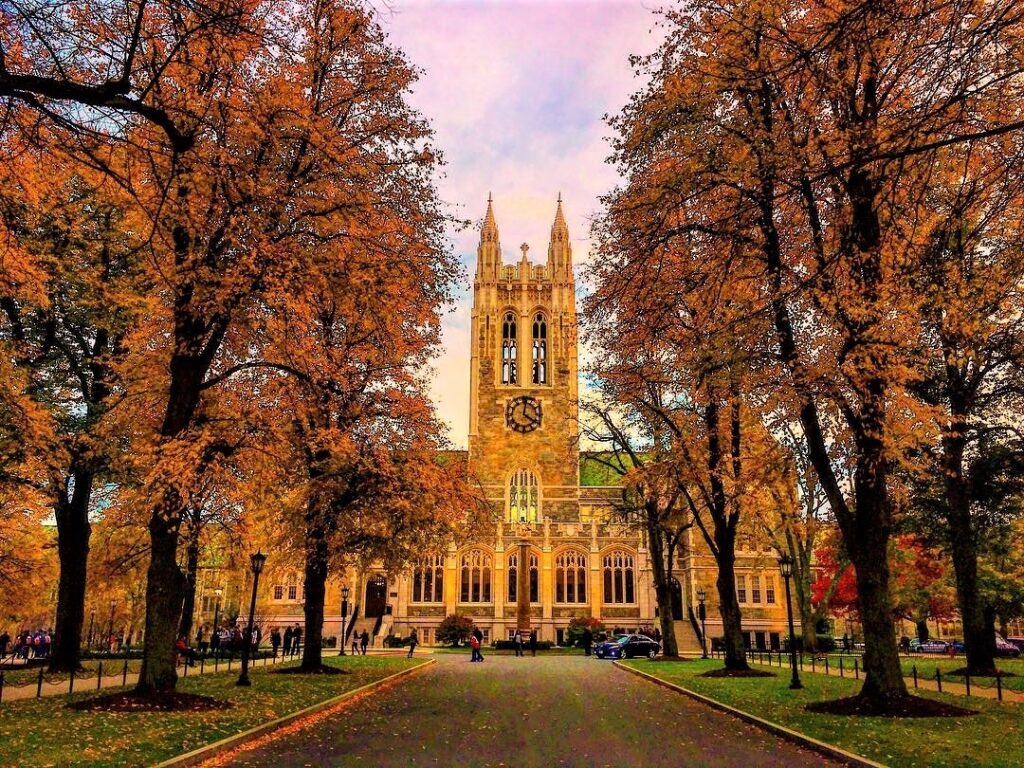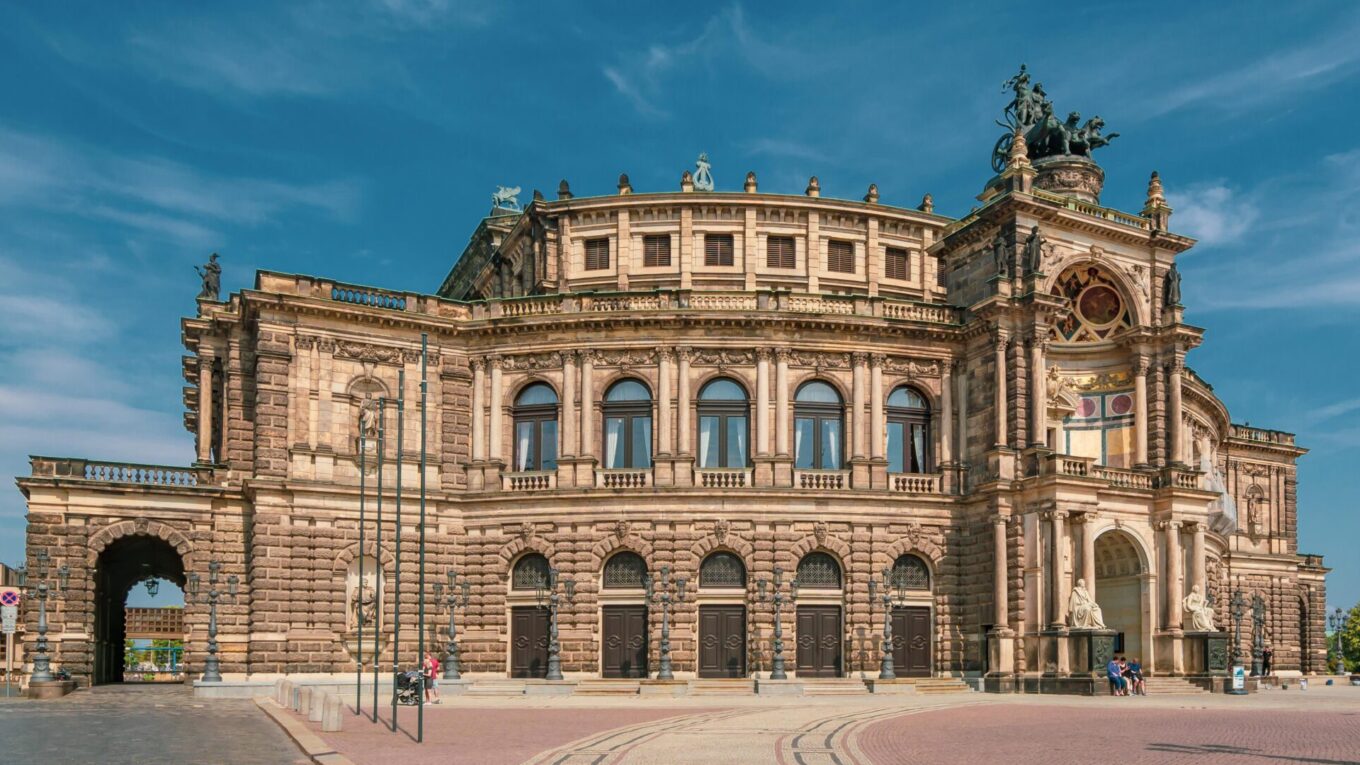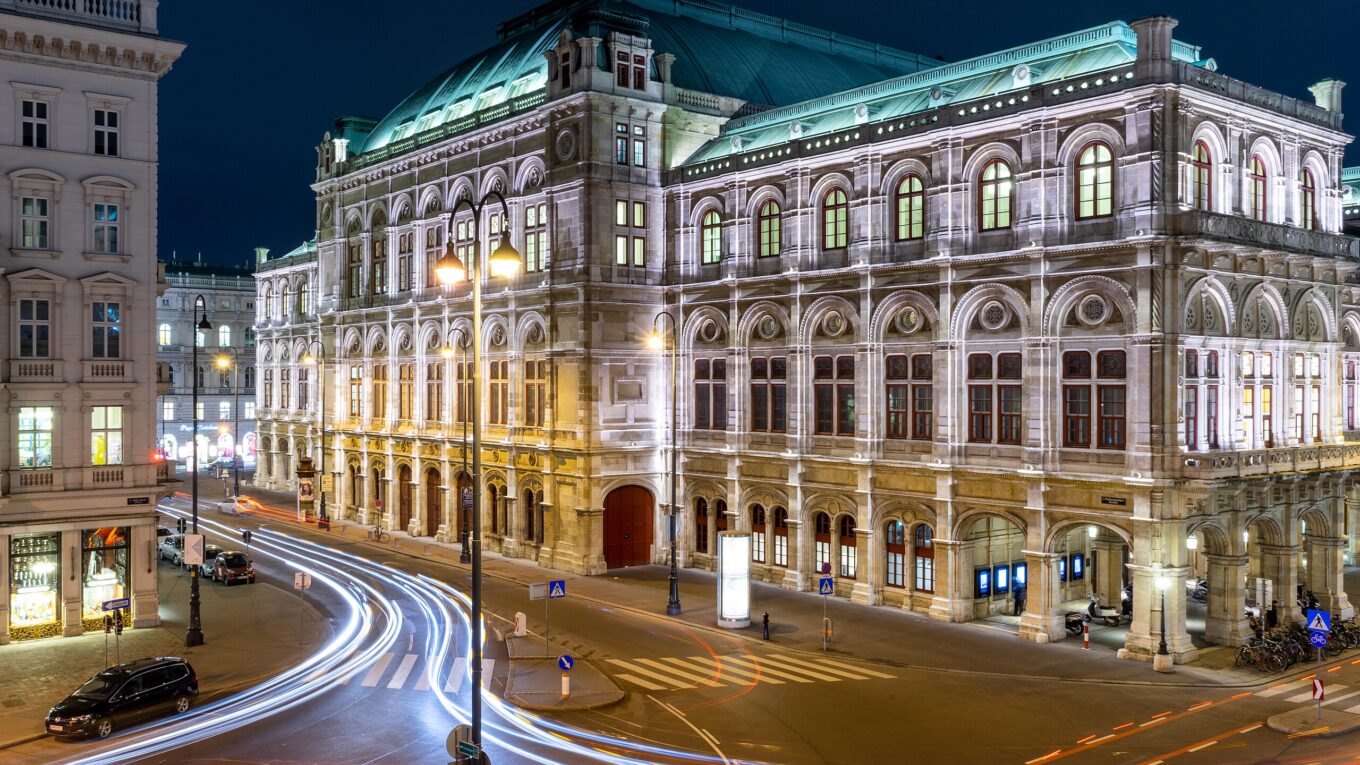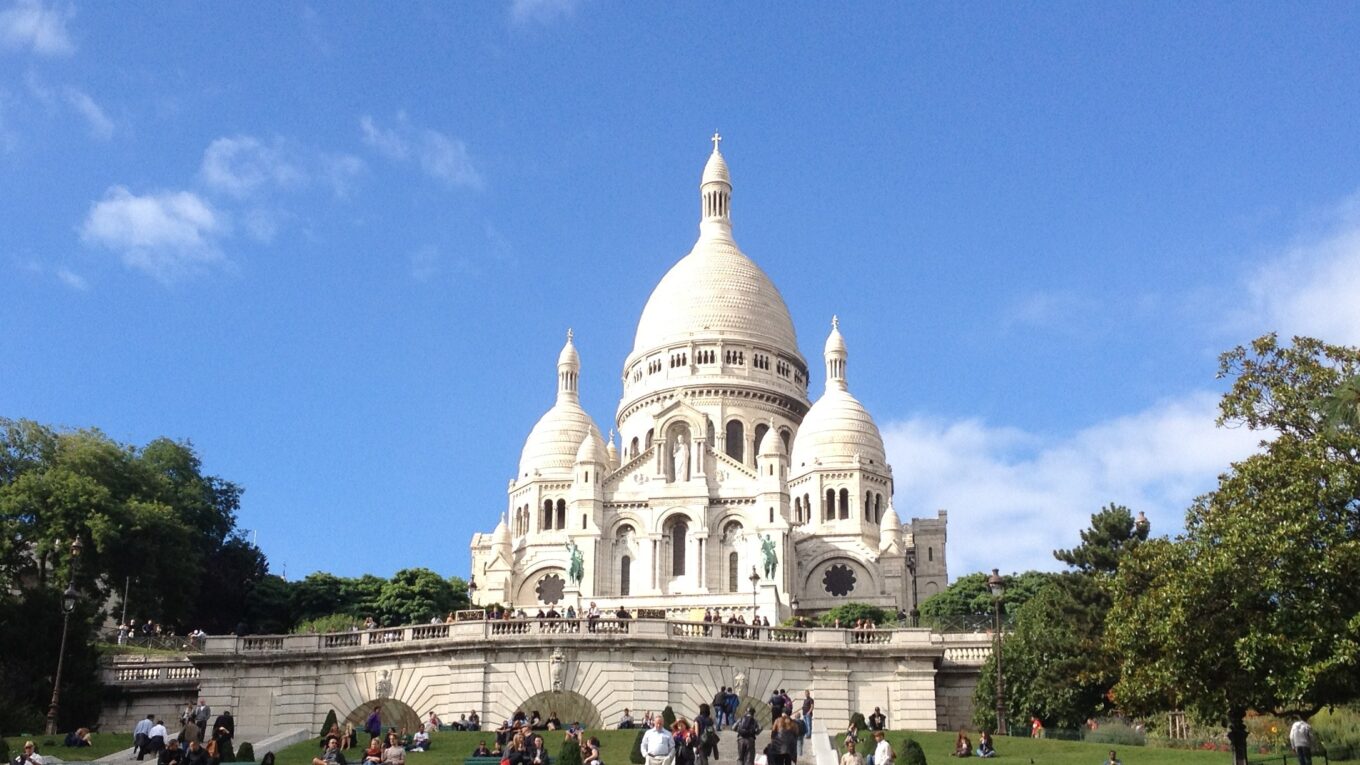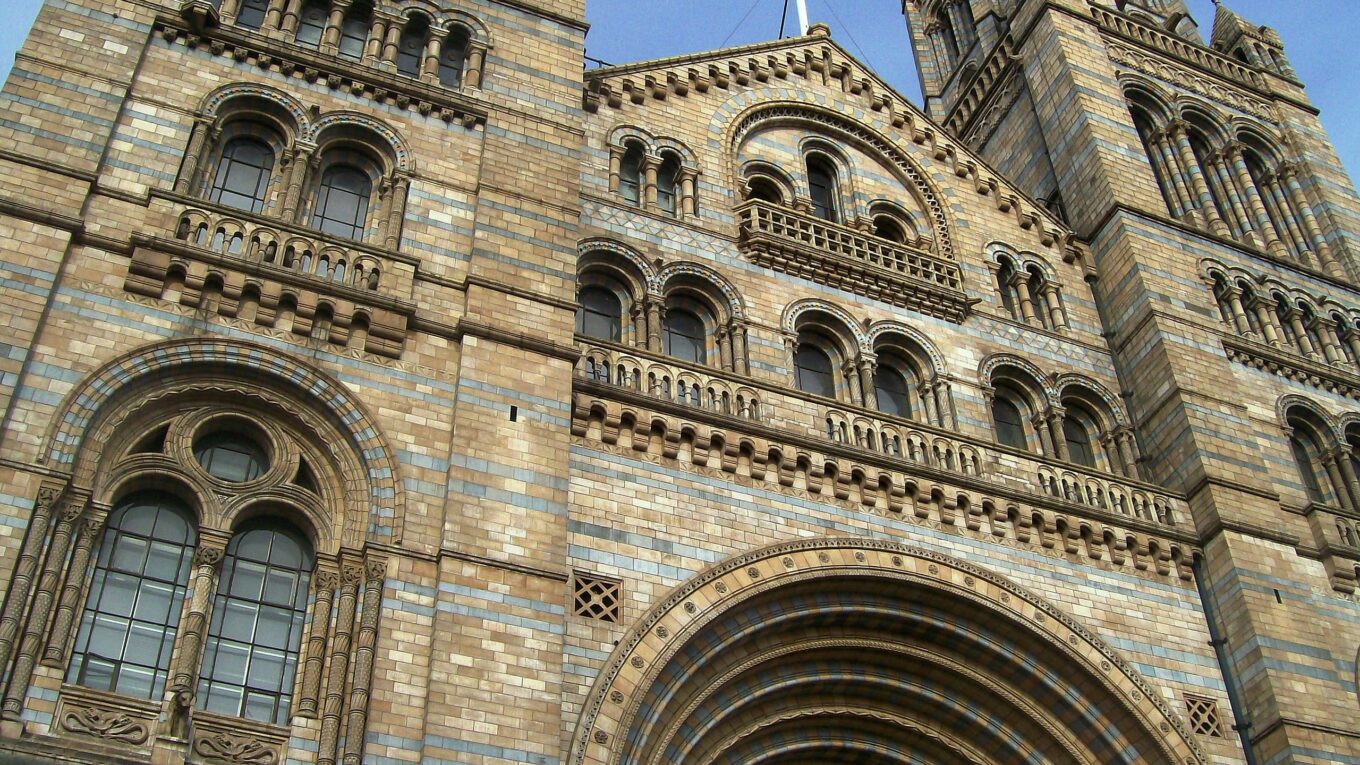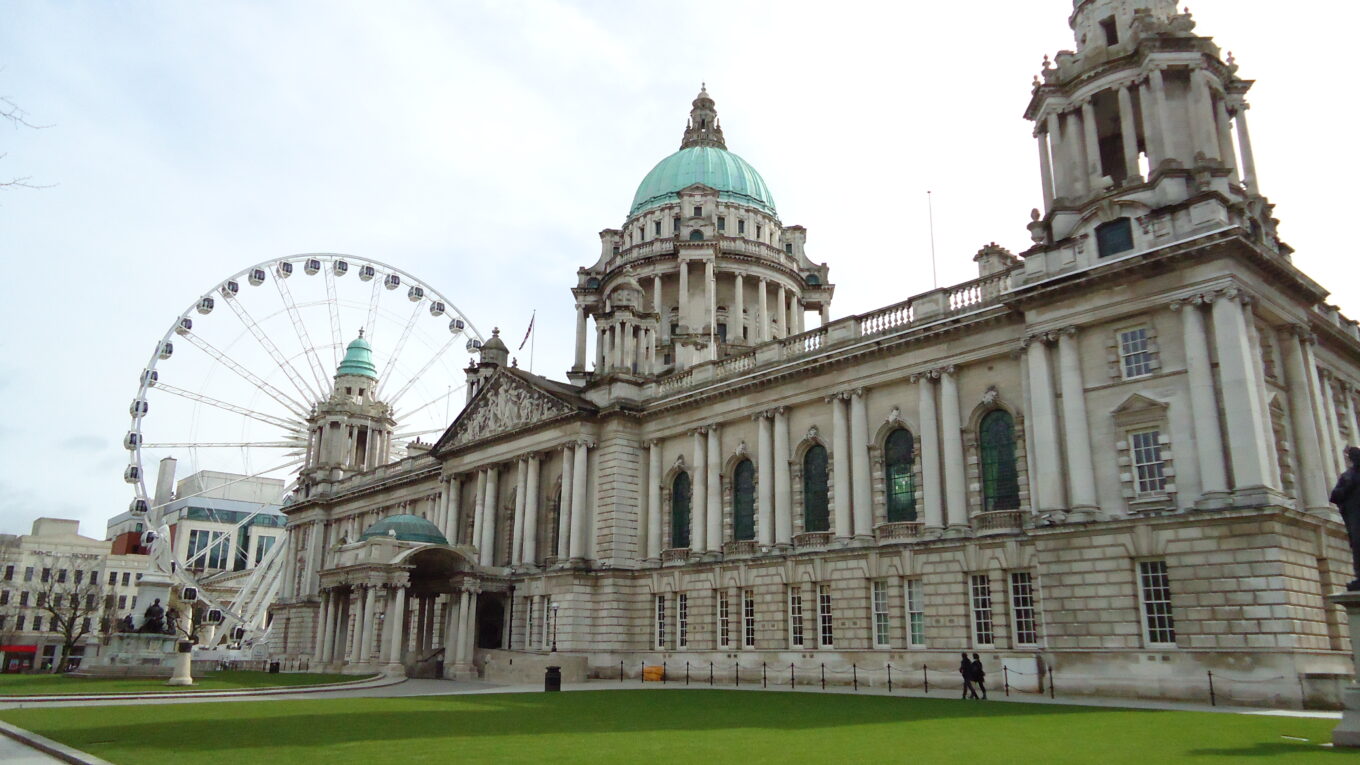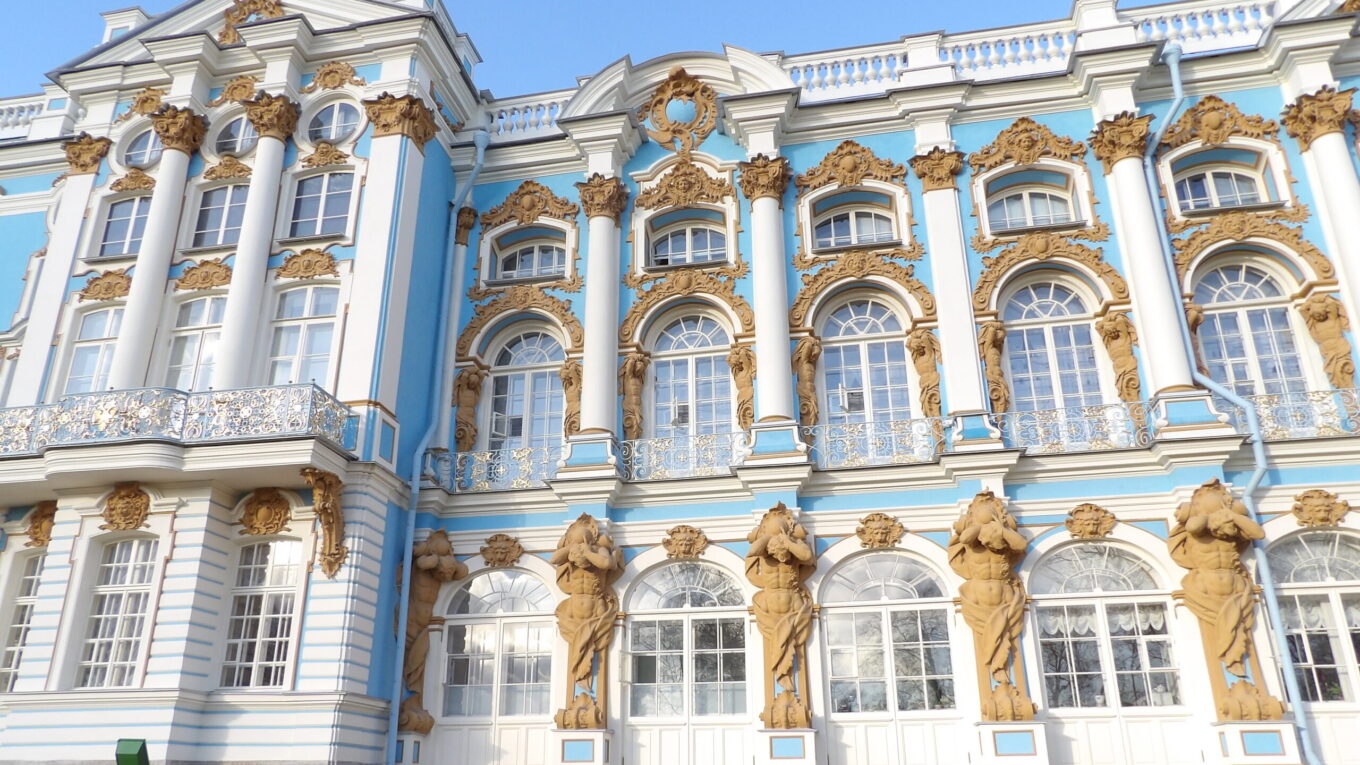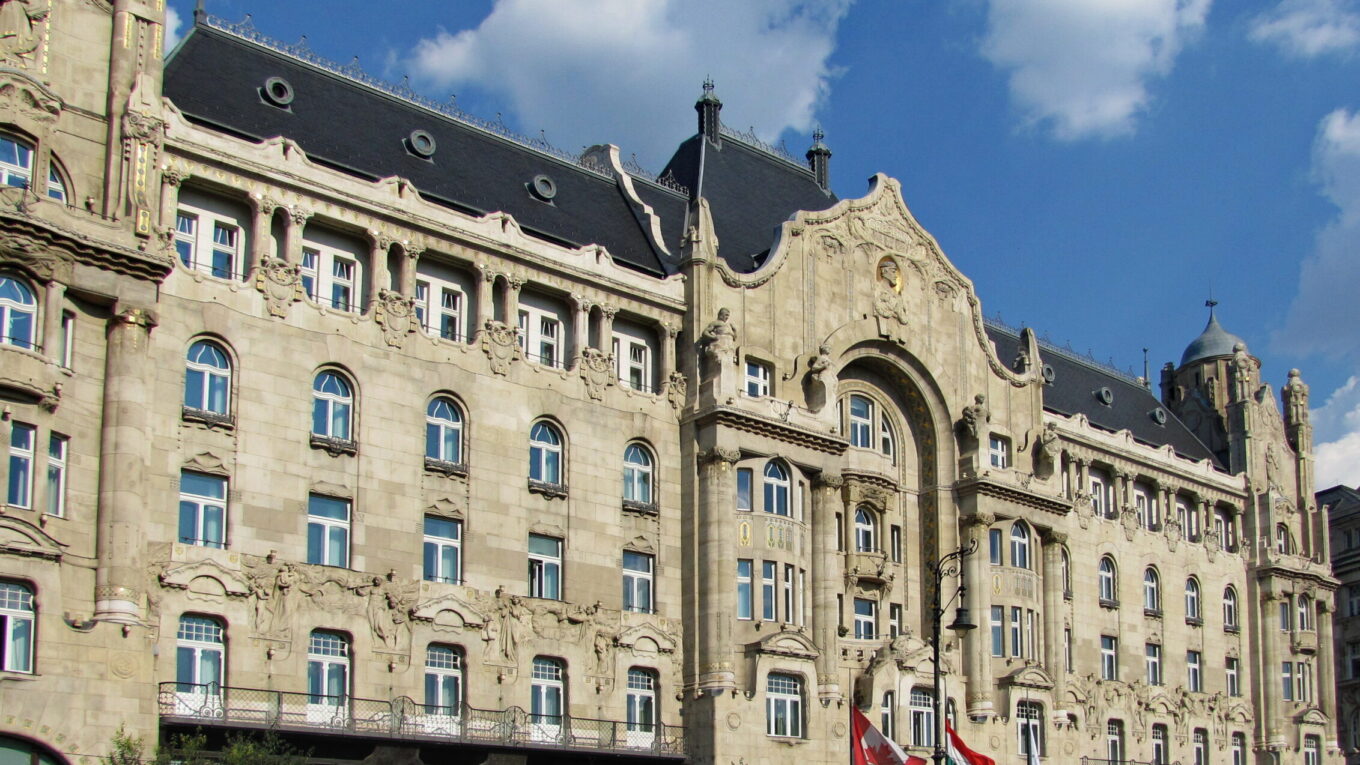Top 25 Examples of Gothic Revival Architecture
Gothic Revival Architecture also referred to as “NeoGothic”, was a form of architecture that was used extensively throughout the Revival Age. The Revival Age began in the 1800s, and it had a focus on replicating the buildings of the past. Gothic Revival Architecture emulates traditional Gothic Architecture, which was popular in Europe from the 13th to the 15th century. Gothic Revival Architecture can be found all over the world, and it is particularly popular within religious, and government buildings. The list below will highlight 25 of the World’s Greatest Examples of Gothic Revival Architecture, and describe the history, characteristics, and impact of the Neogothic Style.
When was the Gothic Revival Period?
The Gothic Revival period was a movement in architecture that emerged in the mid-19th century and continued up until the early 20th century. It was part of a larger movement known as the Revival Period.
There are many different styles of Revival Architecture, but they all revolve around the same theme: replicating the buildings of the past and redesigning them in a new way.
Gothic Revival Architecture coexisted alongside other revival styles, including NeoByzantine, NeoRomanesque, Neoclassical, NeoRenaissance, and NeoBaroque.
Eventually, during the 1920s and 30s, other more fluid and sculptural building forms became popular including Art Nouveau and Art Deco Architecture.
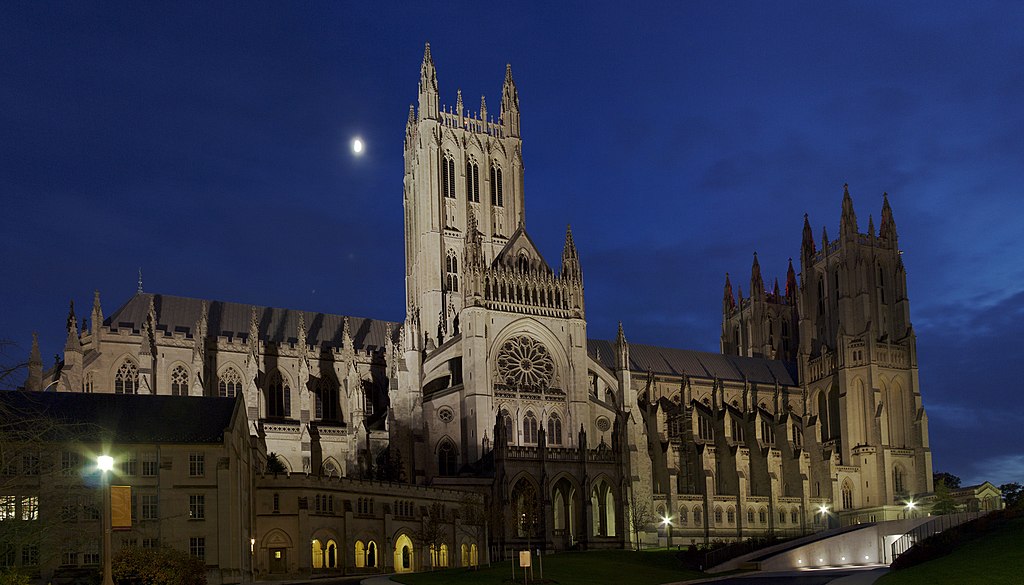
What was the Gothic Age?
The Gothic Age was a period in history that began in the 12th century and lasted until the start of the Renaissance Age in the 15th Century. Gothic Architecture was a building form that utilized pointed arches, stained glass, flying buttresses, and spires. Many Gothic architects designed with one goal in mind, creating towering spaces that would inspire local populations and show the power and might of the Christian Church.
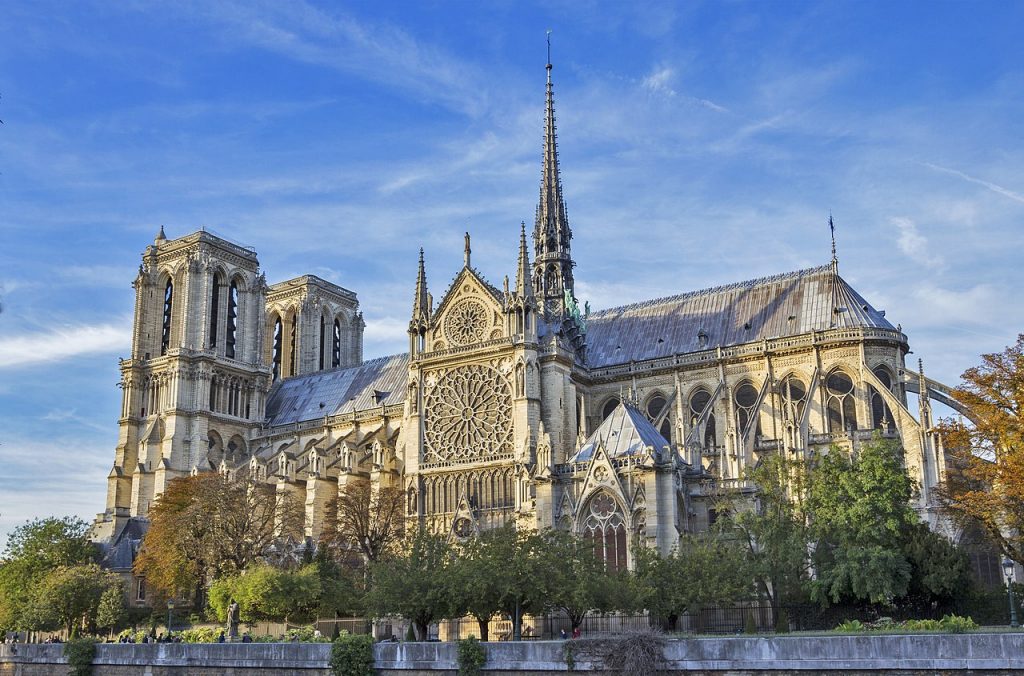
The image above shows one of the world’s most well-known works of Gothic Architecture: Notre Dame in Paris.
Many of the same elements in this building were replicated during the Gothic Revival Period, and thanks to new technologies that emerged in the 1800s, Gothic Revival buildings could be built even taller and larger than those from the Medieval Period.
What’s the difference between Gothic Revival Architecture and NeoGothic Architecture?
There is no difference between NeoGothic Architecture and Gothic Revival Architecture, and the terms are often used interchangeably. Virtually all of the styles from the Revival Period in Architecture can be described in this manner. (Ie…NeoRomanesque vs. Romanesque Revival and NeoRenaissance vs. Renaissance Revival)
Characteristics of Gothic Revival Architecture
Most of the elements within Gothic Architecture can also be found in the buildings of the Gothic Revival Period. Gothic Revival Churches in particular can sometimes look identical to older Gothic Cathedrals, and many museums and government buildings utilize Gothic Detailing in new and exciting ways.
Pointed Arches

Pointed arches, which are often referred to as “Gothic Arches” are one of the most iconic elements found throughout Gothic Revival Architecture. Pointed Arches help distribute the load of the material above, and then they transfer that load down to the building’s foundation. These arches were an important innovation that led to the dizzying heights found in many Gothic Cathedrals. The images above show two different examples of pointed arches within São Paulo Cathedral (left) and the Washington National Cathedral (right).
Flying Buttresses

Flying Buttresses were an important innovation back in the Gothic Age. These buttresses help distribute the weight of the roof above and spread it outward toward the building’s foundation. By the 19th century, newer technologies and materials emerged that made flying buttresses less essential. But, you still see them throughout Gothic Revival Architecture as a way to connect with the buildings of the past. The image above shows an entire row of Flying Buttresses at the Washington National Cathedral in Washington DC USA.
Vertical Emphases
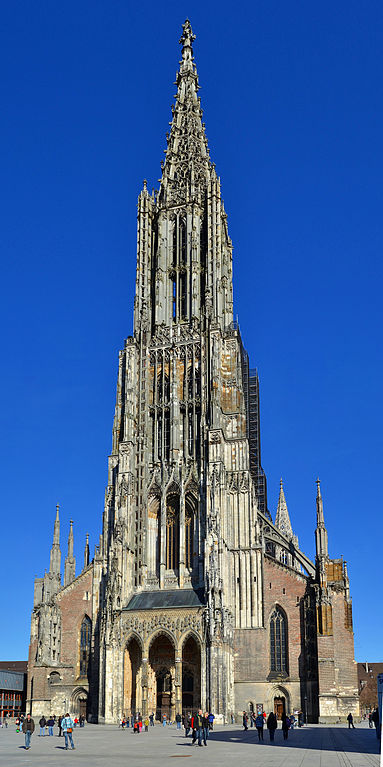
Vertical Emphasis is used throughout Gothic Architecture as a way to make buildings seem tall and mighty. This was a key element in the Gothic Age when most cathedrals were built to immense heights as a way to inspire local populations. In fact, many elements in Gothic Architecture such as pointed arches and flying buttresses are utilized for the purpose of reaching greater heights. This idea of Vertical Emphasis also shows up throughout Gothic Revival Architecture. The image above shows the famous tower at Ulm Minster in Germany, which has held the title of the world’s tallest church since its completion in 1890.
Gothic Tracery
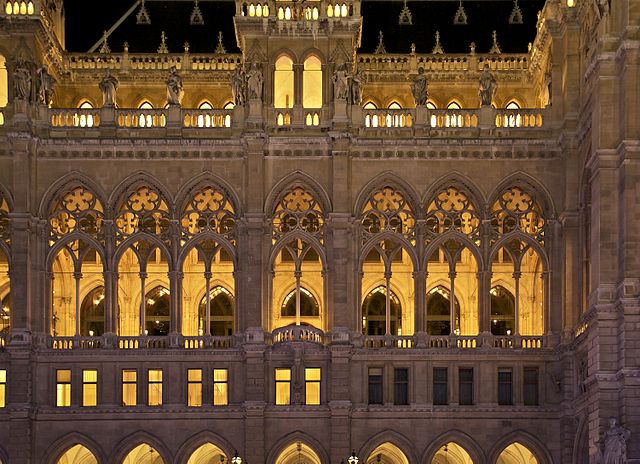
Gothic Tracery is another element found throughout Gothic Revival Architecture. Gothic Tracery is decorative stonework that is found around fenestrations like doors and windows. In the image above you can see some Gothic Tracery within the facade of Vienna City Hall in Vienna Austria. The thin and delicate stonework shows an impressive attention to detail and illustrates the precision and craftsmanship of 19th-century masons.
Gargoyles and other statues
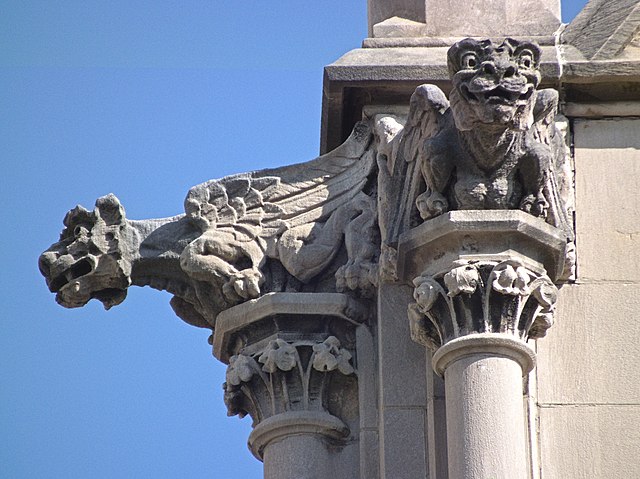
Gargoyles and other statues are elements found throughout many examples of Gothic Revival Architecture. In the image above you can see some Gargoyles decorating column capitals at the exterior of St. Paul’s Cathedral in Pittsburg, Pennsylvania, USA. The church was completed in 1906 and is one of the finest examples of Gothic Revival Architecture in the central United States.
Tympanums
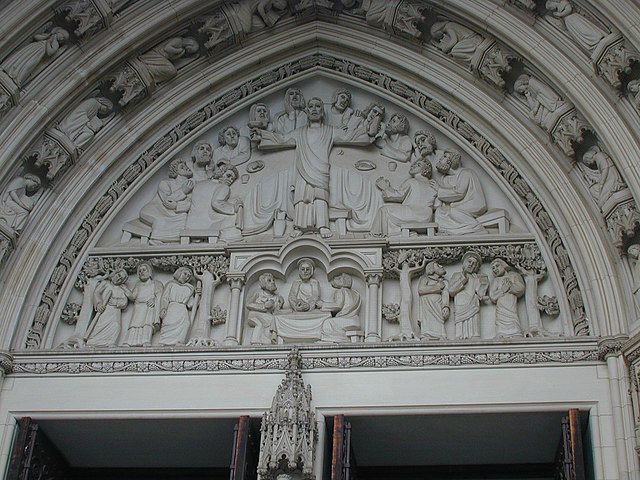
A Tympanum is a decorative archway located above the entrance to a building. They are most often found in churches and other religious structures. Tympanums were popularized in the Romanesque Age, but they were later embellished and expanded during the Gothic Age. Tympanums are often lavishly decorated, and festooned with statues, gothic tracery, and other sculptural elements. In the image above you can see a Tympanum at Washington National Cathedral, which depicts many religious figures and scenes from the bible.
Spires

Spires are one of the most iconic elements found in Gothic Revival Architecture, and the use of spires is a major component in the vertical emphasis found in many Gothic Buildings. During the Gothic Revival Period, architects utilized new innovations and technologies, such as structural reinforcing with iron and steel. These techniques helped buildings reach new heights that were previously unheard of in the original Gothic Age. The image above shows the spire of St. Pancras Station in London, which was a major transportation hub completed in 1868.
Intricate Details

One final feature found throughout Gothic Revival Architecture is the use of intricate details. During the original Gothic Age, many buildings had meticulous carvings and sculptural elements, which contrasted the more simplified forms found in the Romanesque Age. These details got even more over-the-top by the end of the Gothic Age in a time known as the Flamboyant Gothic Period. During the Gothic Revival Era, intricate details were again utilized in a similar way. The image above shows the clock face of “Big Ben” at the Palace of Westminster in London. Here you can see geometric patterns, gothic tracery, pinnacles, and other sculptural elements.
What are the greatest examples of Gothic Revival Architecture?
Gothic Revival Architecture was one of the key typologies within the overall Revival Movement. The list below will highlight 25 of the World’s Greatest Examples of Gothic Revival Architecture, and provide an in-depth look at the history and importance of the Neo Gothic Style.
1. Palace of Westminster – London, England, UK
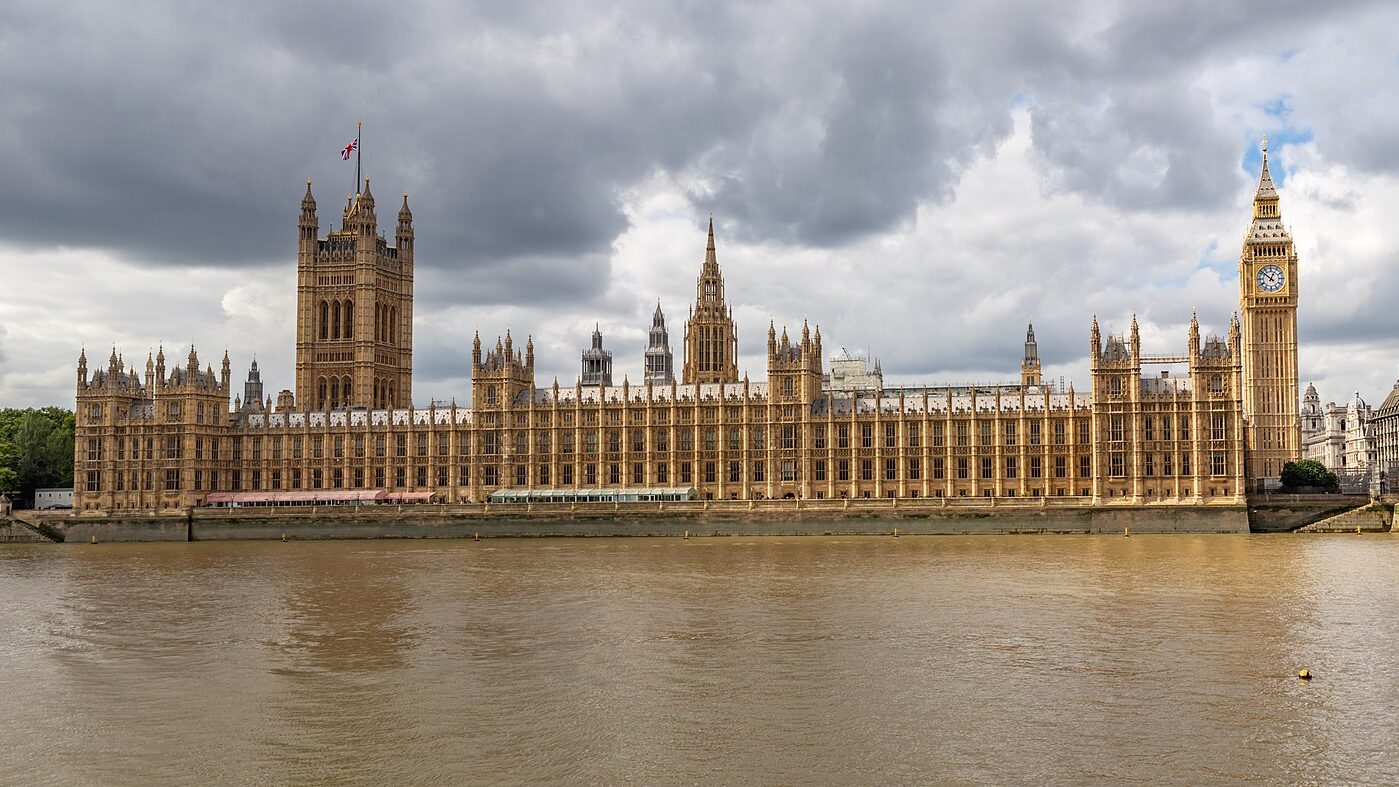
The Palace of Westminster is a famous work of Gothic Revival Architecture overlooking the River Thames in downtown London. Construction began on the building in 1840 and was completed in 1876. The design borrows many elements from the traditional English Gothic Style, including pointed arches, spires, pinnacles, and Gothic tracery. Many of these same elements are found throughout other nearby buildings such as the Tower of London, and Westminster Abbey. The Palace of Westminster contains the House of Commons and the House of Lords, the two main entities within the English Government.
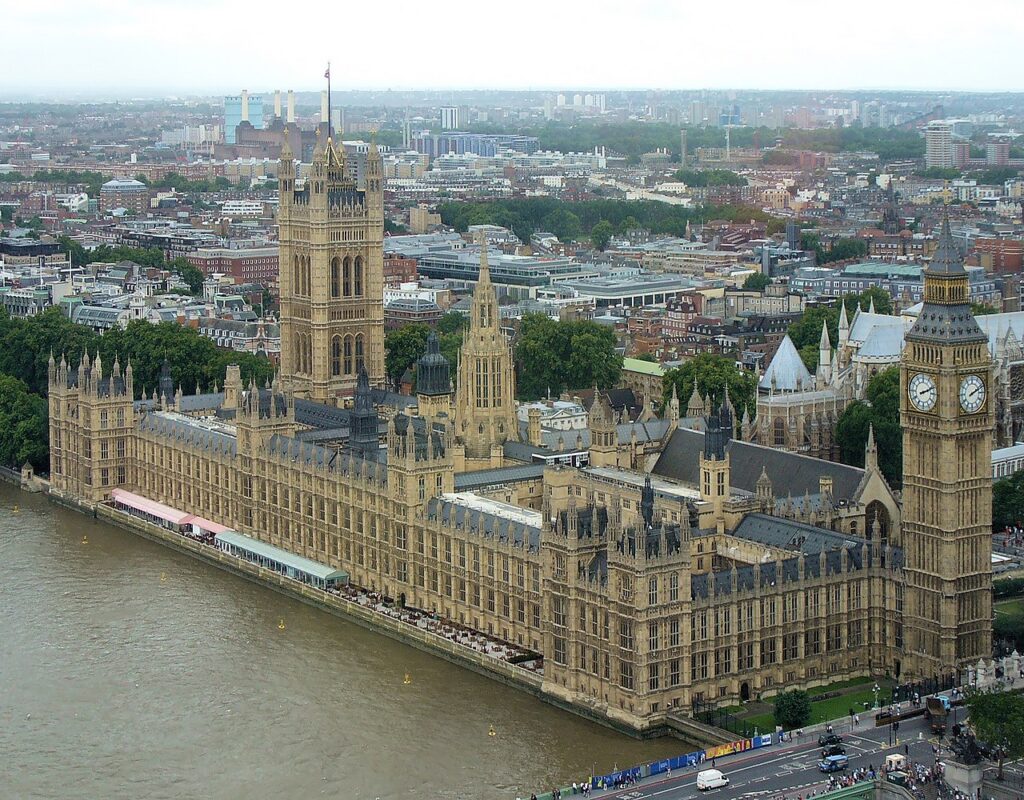
One of the building’s most infamous elements is the 316-foot (96 m) tall clocktower, which is known by the nickname “Big Ben.” Big Ben has long been a symbol of London, and its clockface has been accurately providing time to local people since 1859. Thanks to its striking appearance and location, and its important political status, the Palace of Westminster remains a focal point of English Politics and Culture in the modern age.
2. Hungarian Parliament Building – Budapest, Hungary

One of the nation’s most iconic structures, the Hungarian Parliament Building is a massive work of Gothic Revival Architecture overlooking the Danube River in Budapest. The building officially opened in the year 1902, although large portions of the structure were completed in advance of the famous Budapest Millennium Exhibition of 1896. After a lengthy selection process, officials decided to go with a Gothic Revival Design which had a lot to do with the strong Medieval background of the Hungarian Nation. The design of the Hungarian Parliament Building was also meant to resemble the Palace of Westminster in London in an effort to help connect Hungary with the powers of Western Europe.
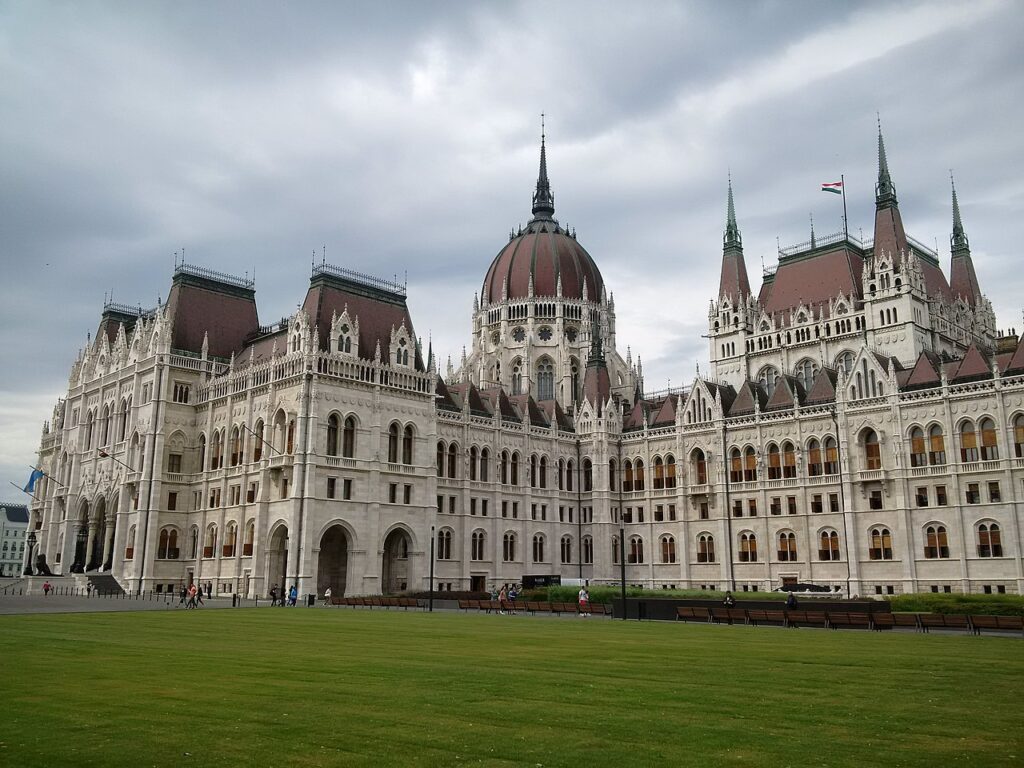
One famous element within the Hungarian Parliament Building is the massive central dome. Domes were a rare design feature back in the original Gothic Age, but, they became more popular in the 19th century. New technologies from the post-industrial age made domes much easier to construct, and they are one example of the many innovations that differentiate Gothic and Gothic Revival Structures. Today the Hungarian Parliament Building still houses the National Assembly of Hungary and it remains one of Budapest’s most popular landmarks, The entire facade was recently restored in the early 21st century, and today the building looks just as good as it did when it first opened a century ago.
3. New Town Hall – Munich, Germany

City officials in the German city of Munich were tasked with constructing a new town hall in the mid-1800s, The site of this new building overlooked the Marienplatz, which is one of Munich’s oldest and most important public spaces. The city decided to utilize a Gothic Revival Design for the structure in order to help it blend in with the area’s other historic works of architecture. The resulting building is an iconic example of the Gothic Revival Style, and it’s become one of the most well-known buildings in the German province of Bavaria.

The central tower of the building tops off at 278 feet (85 meters) tall, and it features a prominent astronomical clock. The clock is a wonder of 19th-century engineering, and it contains a host of statues and figurines that perform a whimsical ceremony each time the clock strikes the hour, Today the New Town Hall still houses the Munich City Councill Chambers, as well as offices for the mayor and other city officials.

Gothic was the dominant architectural style in Europe during the early Middle Ages. Check out our article on the Top 25 Examples of Gothic Architecture to learn more!
4. St Patrick’s Cathedral – New York City, New York, United States
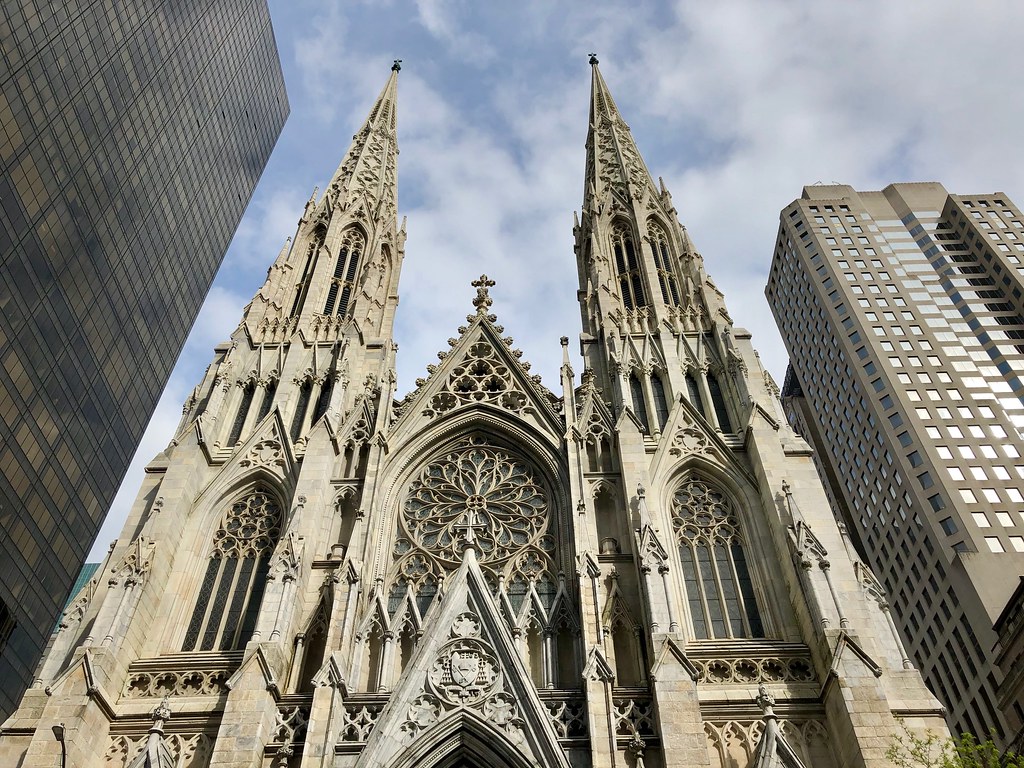
St. Patrick’s Cathedral is one of the many incredible 19th-century Cathedrals in The United States. It’s located in Midtown Manhattan, one of the densest neighborhoods in the entire world. Construction began on the church in 1858 and lasted for over 20 years. The striking Gothic Revival design was chosen to emulate the many Gothic Cathedrals throughout Europe. It was also meant to cater to the large European immigrant population living in New York City during the 1800s.

St. Patrick’s Cathedral is located in the heart of Midtown at the corner of 5th Avenue and 50th Street. It’s close to many other New York City Landmarks like Rockefeller Center, Times Square, and Central Park. The church holds frequent masses and also hosts weddings and funerals. Although it was one of the tallest structures around upon completion, today the spires of St. Patrick’s church are dwarfed by the area’s many Skyscrapers.
5. Canadian Parliament Building – Ottowa, Ontario, Canada

One of the most striking buildings in all of Ottawa, the Canadian Parliament Building is an iconic work of Gothic Revival Architecture. It was completed in 1927, and it replaced an earlier building that burned down in 1916. The Canadian Parliament building contains the chambers for the two main branches of the Canadian Government, the House of Commons and the Senate. The parliament building is one of the most recognizable structures in all of Canada, and it’s featured on several different denominations of Canadian currency.

The Canadian Parliament Building contains all of the main elements found in Gothic Revival Architecture. The main tower is the building’s most striking element, and its height and steeply pointed roof help the building resemble other structures from the Gothic Age. In the image above you can also see the Library Of Parliament, which is a round Neo Gothic hall located directly behind the main Parliament Building. This structure survived the great fire of 1916, and it is known for its Flying Buttresses and Stained Glass Windows.
6. Brussels City Museum – Brussels, Belgium

Brussels City Museum is a Gothic Revival Building located within the city’s most popular public square, the Grand-Place. It was completed in the late 19th century and replaced a much older building with origins dating to the 16th century. The museum was designed to mimic the nearby Brussels Town Hall, which is a Gothic Building that was completed in 1455. Both structures share similar traits including Gothic Tracery and a central spire. Brussels City Museum and the entire La Grand-Place were designated as a UNESCO World Heritage Site in 1998.
7. Las Lajas Sanctuary – Ipiales, Colombia

Known for its striking position, Las Lajas Sanctuary is an incredible example of Gothic Revival Architecture and one of Columbia’s most well-known buildings. The church is built on the side of a steep ravine that has been cut by a small river. The building cantilevers outward from the hillside and is supported by a tall foundation that carries the weight of the structure toward the riverbed below. The church is accessible via a short bridge that connects across the ravine. Las Lajas is unlike many other buildings from this time period, and it remains a popular pilgrimage church for many people from South America.
8. Washington National Cathedral – Washington DC, United States
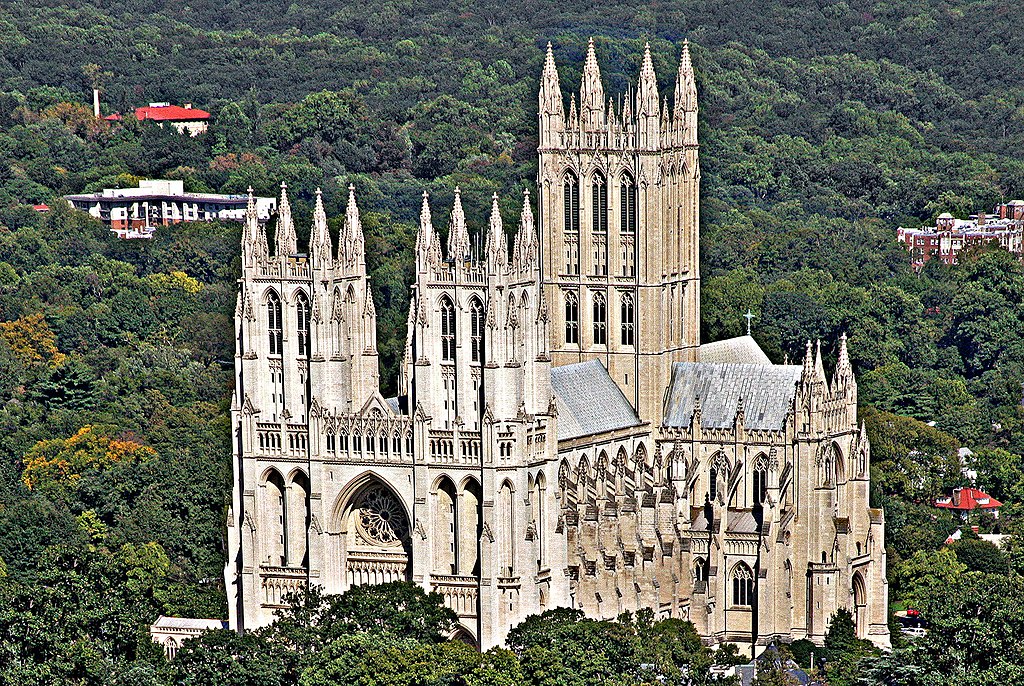
Washington National Cathedral is another example of the many Gothic Revival Cathedrals that can be found throughout North America. Work began on the church in 1907, making it a relatively late work of Gothic Revival Architecture. The church was designed to precisely replicate several older cathedrals, including Westminster Abbey and Canterbury Cathedral. The builders were so meticulous with the design, that if you didn’t know it was a 20th-century building, you might think it was an original structure from the Gothic Age.
9. Rossio Station – Lisbon, Portugal
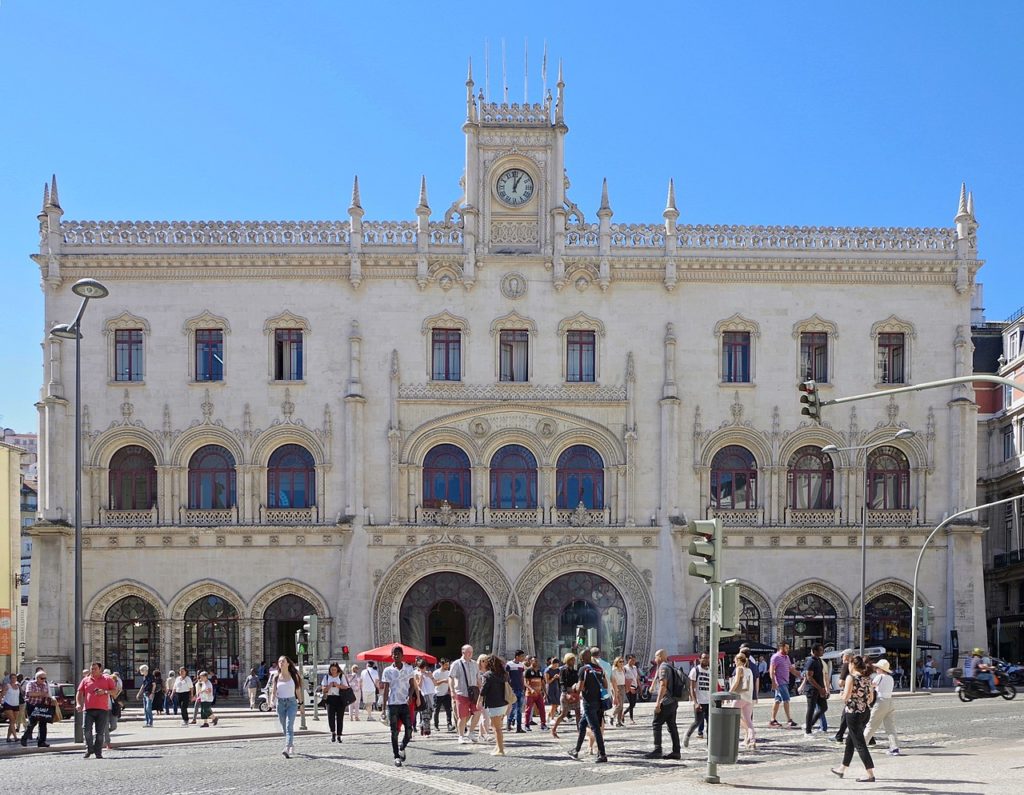
Rossio Railway Station is one of the largest transportation hubs in the city center of Lisbon. The main station building is located right in between Rossio Square and Restauradores Square. The station houses several railway lines that connect Lisbon to nearby cities such as Sintra, Coimbra, and Porto. Rossio Station’s facade was designed in the Neo-Manueline Style, with pointed arches, pinnacles, and other Gothic details throughout. It resembles other structures from Lisbon’s Golden Age of Discovery when Manueline Architecture was being constructed by Portuguese Kings like Manuel I.

Interested in Lisbon? Check out our article on the Architecture of Lisbon to learn more about the city’s historic buildings!
10. Vienna City Hall – Vienna, Austria
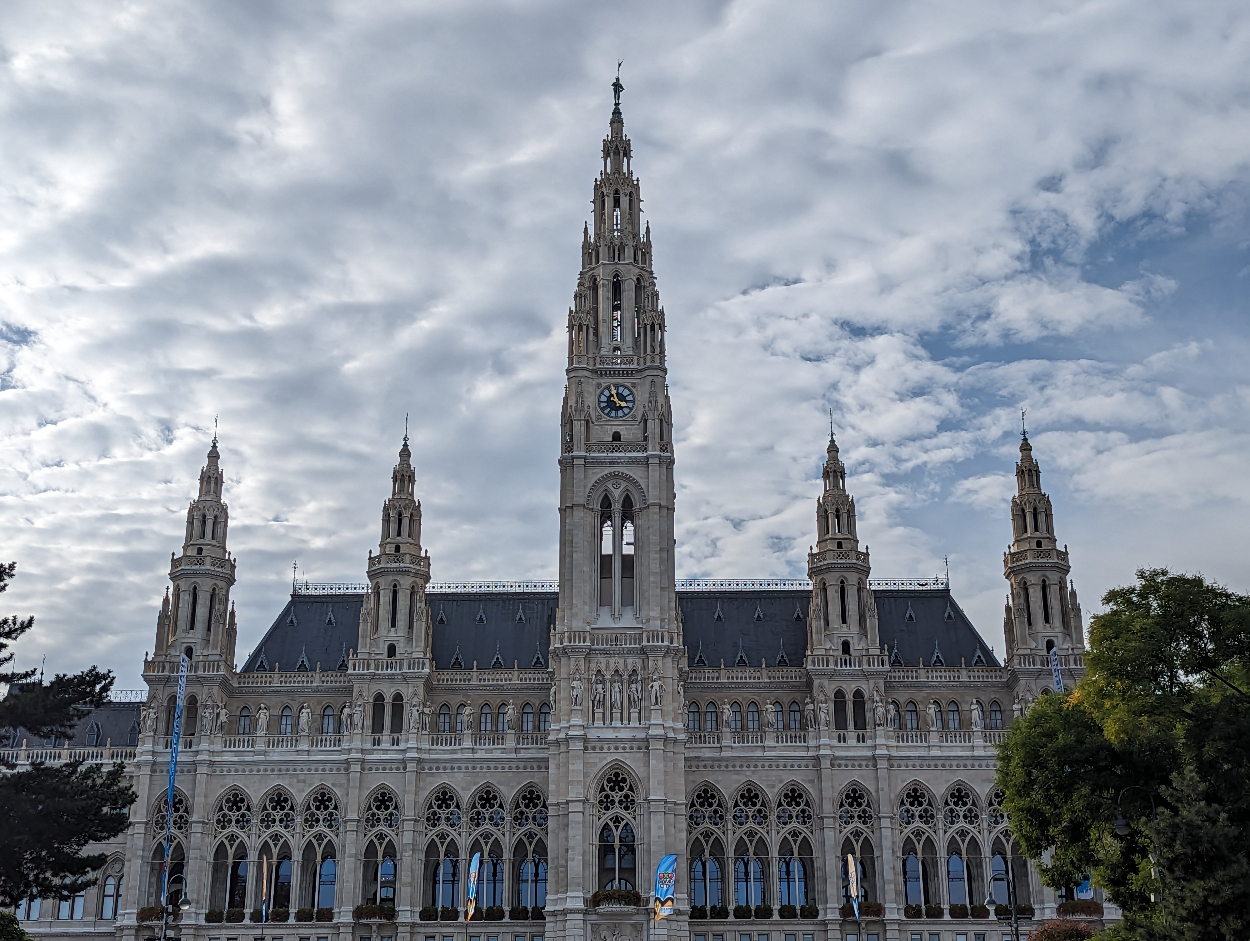
Vienna is the capital of Austria and is situated on the banks of the Danube River. Up until the 18th century, Vienna was surrounded by a ring of defensive walls and fortifications. However, by the 19th century, these walls were obsolete and were subsequently torn down. Once demolished, the walls were replaced by a ring road lined with parks, monuments, and prominent buildings. Today this area is known as the Ringstrasse or the “Vienna Ring Road.” The Ringstrasse is known for its assortment of different Revival-style buildings. One of these is Vienna City Hall, which is a work of Gothic Revival Architecture that houses the local government of Vienna.
11. Basilica of Our Lady of Luján – Luján, Buenos Aires, Argentina

Luján is a municipality located just outside of Buenos Aires Argentina. It’s home to the Basilica of Our Lady of Luján, one of the greatest works of Gothic Revival Architecture in all of South America. The church opened its doors in the 1930s making it one of the newer buildings on this list. And like many other churches from this time period, the Basilica of Our Lady of Luján is wholistic and unflinching in its Gothic Appearance. The church looks almost exactly like earlier Gothic Cathedrals found throughout Western Europe and it contains all of the classic Gothic Elements such as spires, pointed arches, stained glass, Gothic Tracery, and a strong vertical emphasis.
12. St. Mary’s Cathedral – Sydney, Australia
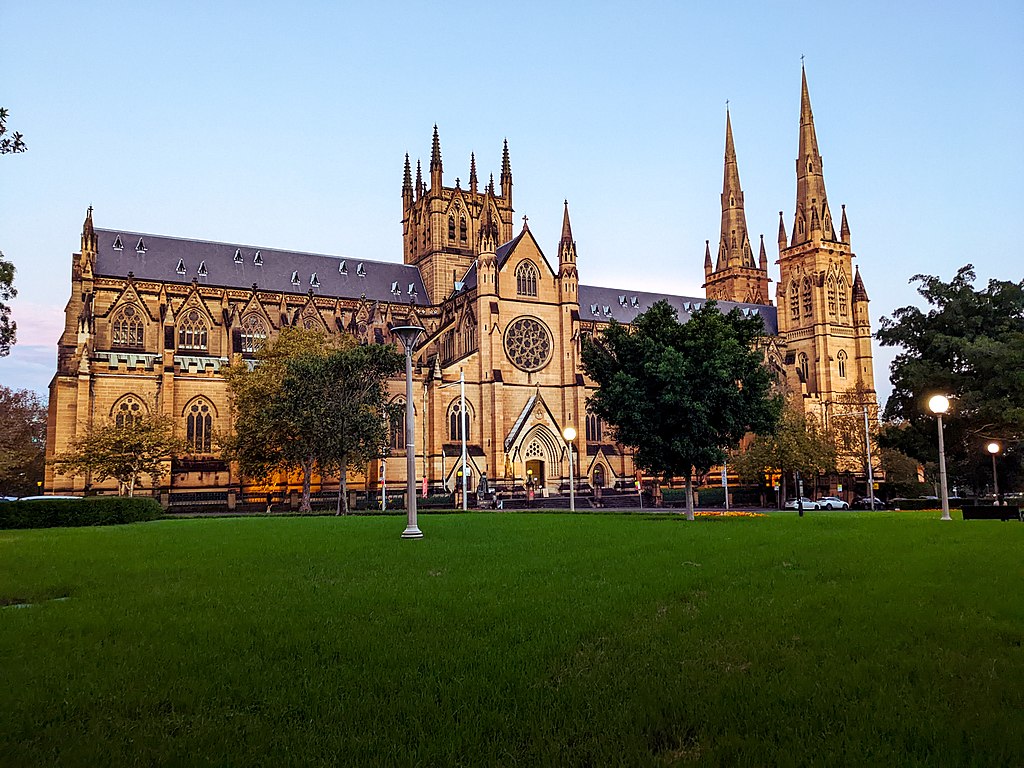
St. Mary’s Cathedral is the main Catholic Church in Sydney Australia. Like many older Cathedrals from Europe’s Gothic Age, St. Mary’s was constructed in phases. Work began in the late 1800s, and lasted until the spires of the church were completed in the year 2000. Australia was a colony in the British Empire for a long time, and the nation has always had strong ties with Great Britain. The design of St. Mary’s Cathedral embodies this connection, as it resembles many older examples of traditional English Gothic Architecture.
13. Tribune Tower – Chicago, Illinois, United States

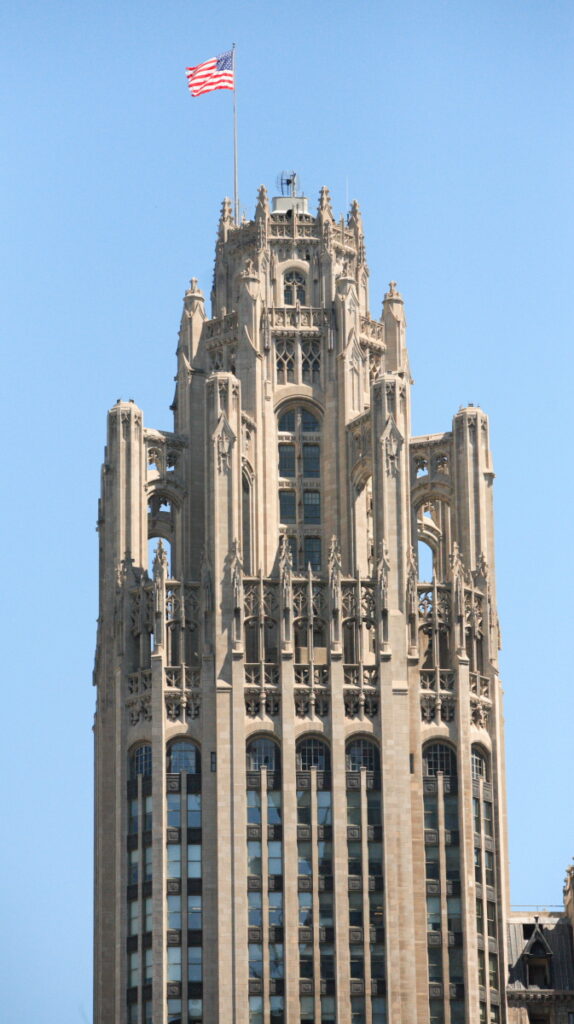
(right) Photo by Ray Dumas from Wikimedia Commons
The only Skyscraper on this list, Tribune Tower is a 36-story building located in downtown Chicago. It was built to house the offices of the Chicago Tribune, the main newspaper in Chicago, Illinois. The tower itself doesn’t contain an abundance of Gothic Revival details, but the very top of the building is embellished with some of the main elements found in the Gothic Style. In the right image above, you can see the top few floors of the tower, which are outfitted with pinnacles, buttresses, and Gothic tracery. Tribune Tower also has a strong influence from Art Deco Architecture, which was popular with many American Skyscrapers.
14. London Tower Bridge – London, England, UK
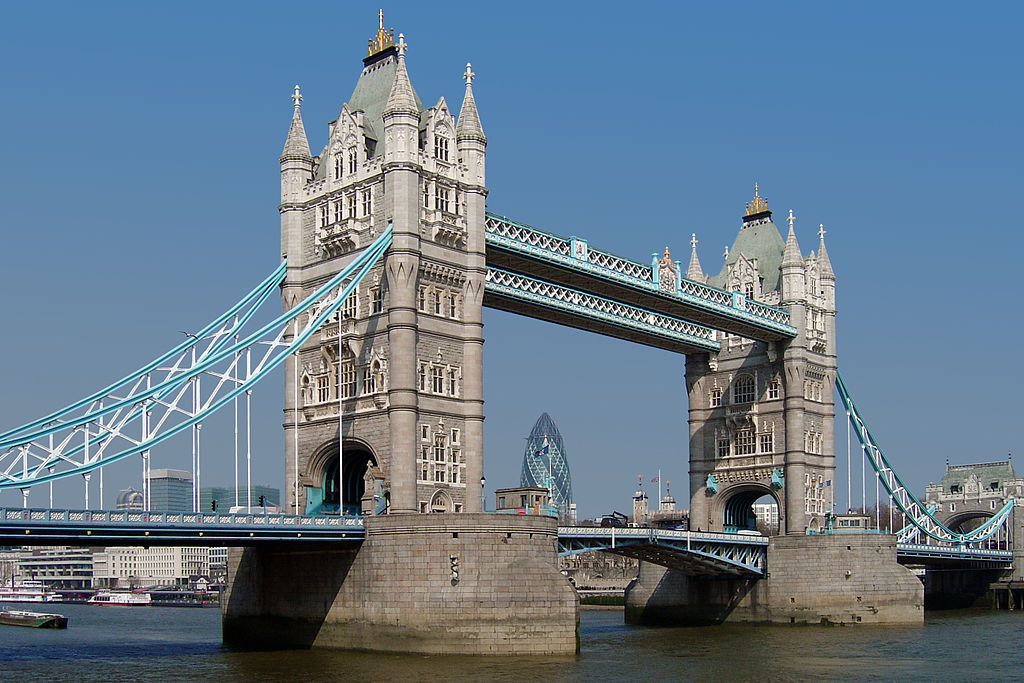
London Tower Bridge is one of a handful of bridges crossing the Thames River in central London. It was constructed between 1886 and 1894 and connects several neighborhoods in the eastern part of the city. The two main towers of the bridge were constructed in the Gothic Revival Style, and they contain all of the typical elements found in Gothic Architecture. At the time of its completion, the bridge was a very innovative piece of engineering. It was built with a hydraulic system that could raise and lower the main deck, allowing taller ships to pass underneath. Today London Tower Bridge is one of the city’s most iconic landmarks, and thousands of cars and pedestrians cross over the bridge each day.
15. St Paul’s Cathedral – Melbourne, Australia
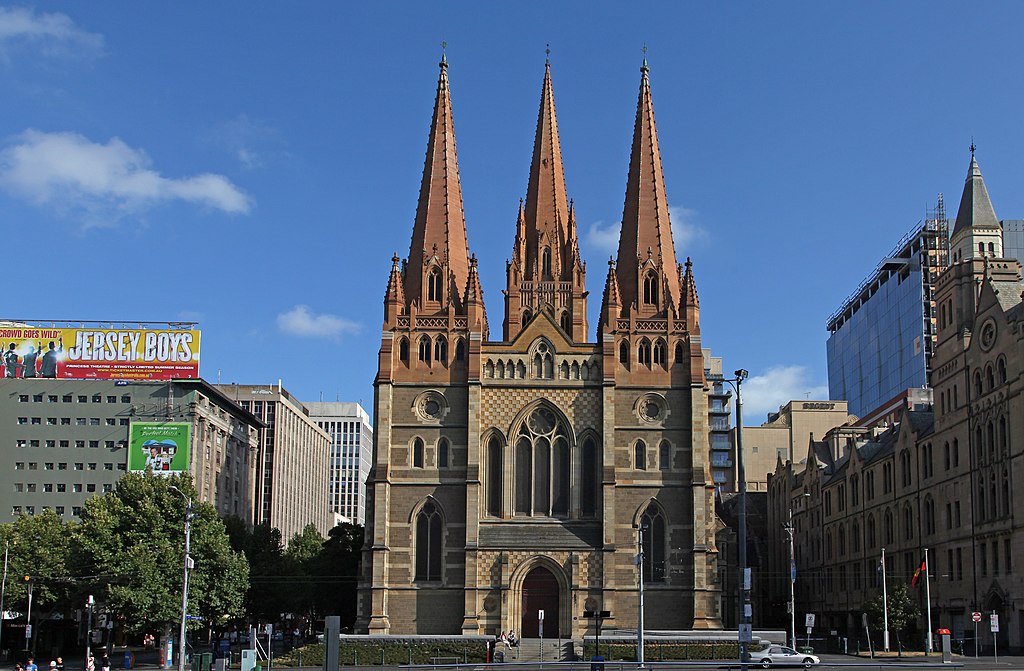
St. Paul’s is the principal church for the city of Melbourne. Like many cities across the globe, Melbourne saw a large influx of people during the late 19th century. Many people were in search of better-paying jobs that were readily available within Melbourne during the Industrial Revolution. Naturally, the city needed a large house of worship to support this growing population. Work subsequently began on St. Paul’s Cathedral in the year 1880. One unique feature of St. Paul’s is that the three main spires were completed later on during the 20th century, and they are made from a different type of red sandstone than the rest of the building.
16. Memorial Hall at Harvard University – Cambridge, Massachusetts, United States
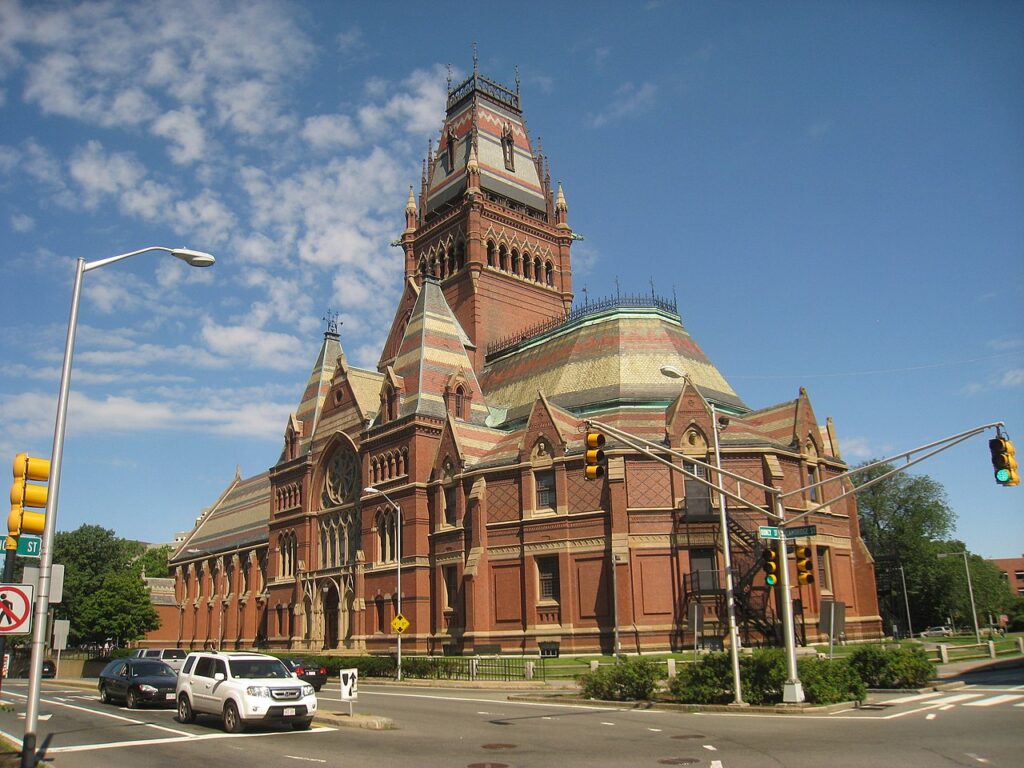
Harvard University was founded in 1636, and it’s one of America’s most prestigious colleges. Like many schools from this period, the campus is filled with an array of Revival Style Buildings. In addition to the NeoRomanesque Austin Hall, the campus also includes Memorial Hall which was designed in the Gothic Revival Style. Memorial Hall is interesting for its use of color. While many Gothic Revival Buildings are made from one type of stone, Memorial Hall contains a variety of materials and colors that combine in an interesting way. Although this aesthetic makes Memorial Hall look different from traditional Gothic buildings, other elements such as the pointed arches and the stained glass help provide a more traditional Gothic look.
Like Architecture of Cities? Sign up for our mailing list to get updates on our latest articles and other information related to Architectural History.
17. Hohenzollern Castle – Bisingen, Germany
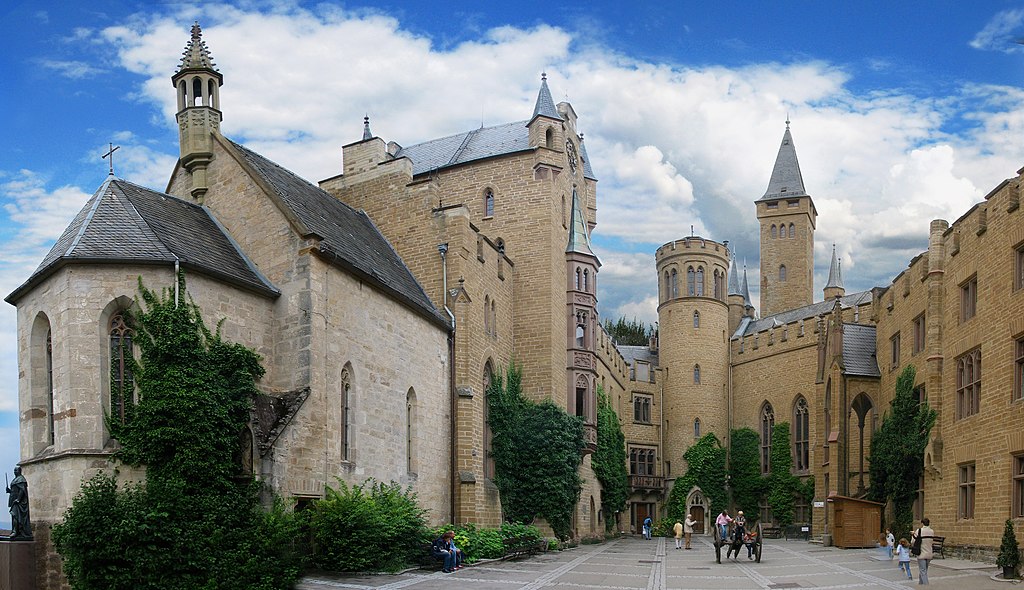
Hohenzollern Castle is a Romantic Age Castle that was completed in 1867. The Romantic Age is synonymous with Romanticism in Architecture, and this movement existed along a similar timeline to the Revival Age. Hohenzollern Castle was an older fortress with foundations dating back as far as the 11th century. The building combines the ideas behind Romanticism and Gothic Revival Architecture and features all of the typical Gothic elements like pointed arches, towers, and pinnacles. Although the castle looks quite formidable, it’s actually not intended for defense at all, and it’s really more of a luxury residence than a fortress.
18. Scott Monument – Edinburgh, Scotland, UK
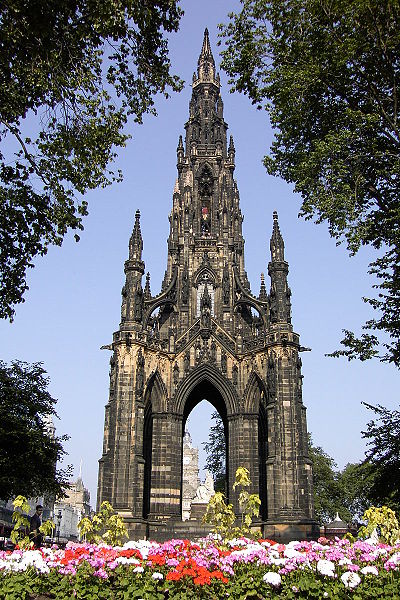
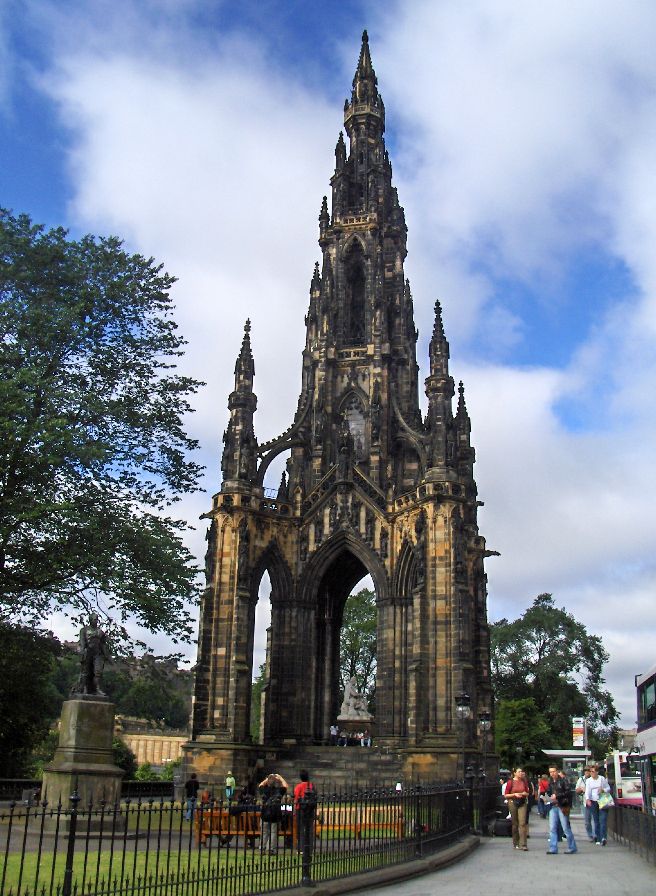
The Scott Monument is a work of Gothic Revival Architecture built in the mid-19th century to commemorate the writer Sir Walter Scott. Scott is known for his many literary works including Ivanhoe and Waverly. The Scott Monument stands over 200 feet (61 m) tall and contains many Gothic elements like pointed arches, vertical emphasis, and Gothic tracery. The Scott Monument is also made from the same weathered sandstone that is found throughout the Architecture of Edinburgh, in other buildings like Edinburgh Castle and St. Giles Cathedral.
19. Oxford University Museum of Natural History – Oxford, England, UK
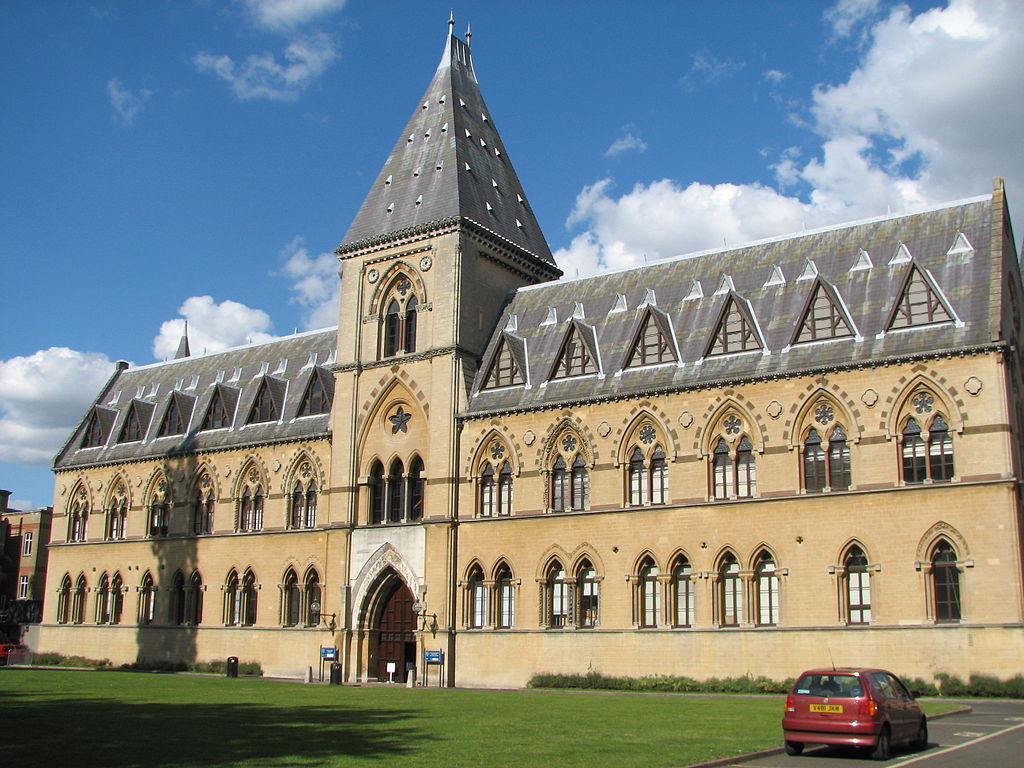
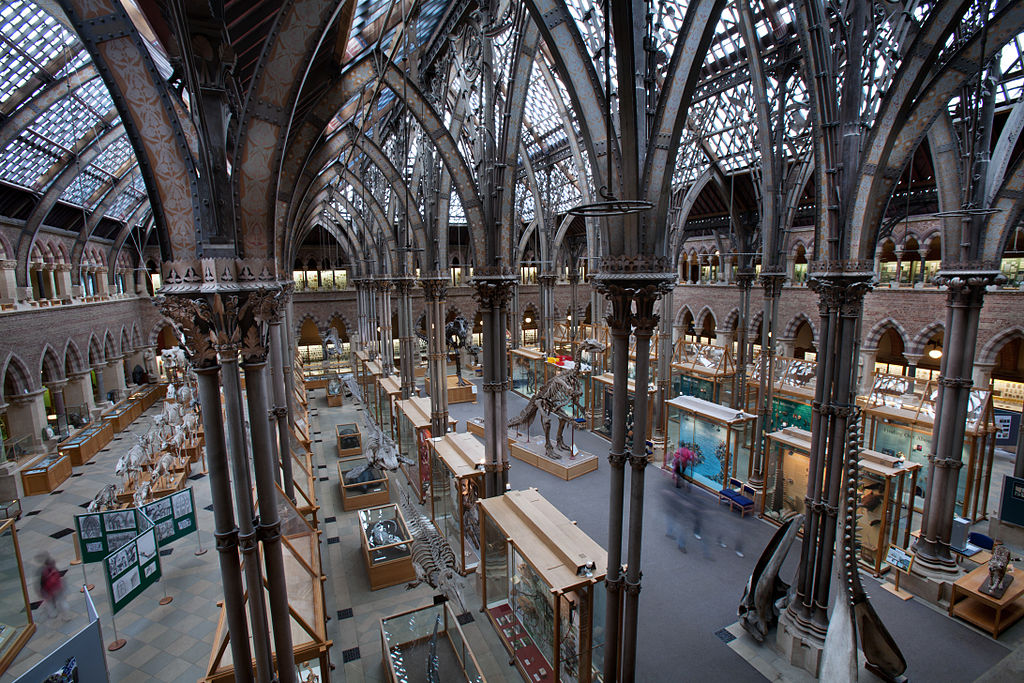
(right) Photo by Jorge Royan from Wikimedia Commons
Oxford University has one of the world’s most beautiful college campuses, and it’s home to dozens of noteworthy buildings. Many of the institution’s most iconic structures date to the Revival Age of the late 19th and early 20th centuries. The Oxford Museum of Natural History is a unique work of Gothic Revival Architecture and it contains a blend of traditional and new-age materials. While the exterior is made of stone, much of the interior is constructed of a cast iron frame topped with a glass skylight. This blend of old and new materials is a unique feature commonly found in buildings from this time period.
20. Cathedral of St. John the Divine – New York City, New York, United States


The Cathedral of St. John the Divine is an unfinished work of Gothic Revival Architecture located on the upper west side of Manhattan Island in New York City. Work originally began on the structure in the year 1892, but eventually funding dried up and there wasn’t a strong push to keep working on the building. The church remains unfinished, and in the left image above you can see the towers of the building are only partially complete. Today thanks to the help of donations, progress is slowly being made on some of the cathedral’s unfinished areas, but it’s unknown if and when the building will be completed.
21. St. Pancras Station – London, England, UK
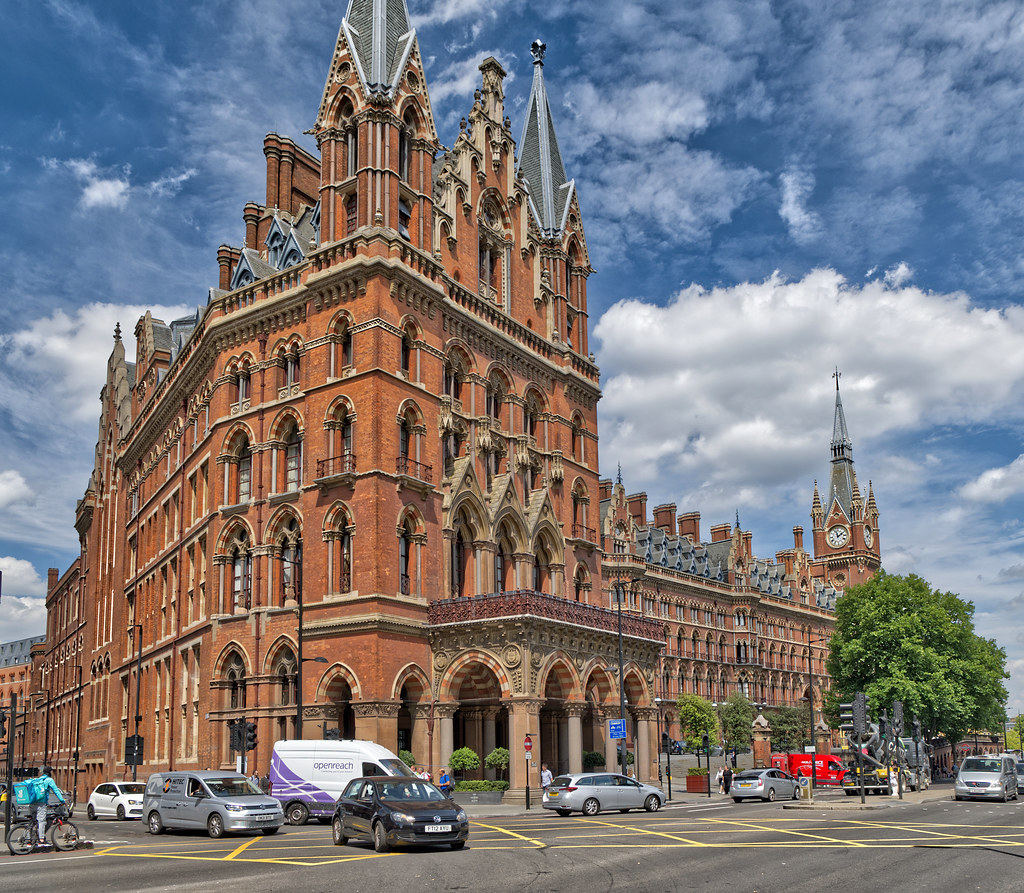
St. Pancras Station is a large transportation hub located in London. It’s a major railway station that connects the city with other places throughout the United Kingdom. The station originally opened in 1868 during the heart of the Revival Movement and the Industrial Revolution. The exterior of the station is designed in the Gothic Revival Style and it contains an assortment of Gothic elements like pointed arches and spires. The majority of the building is made from red bricks and there is also a two-tone masonry pattern utilized around many of the exterior fenestrations. The Gothic Revival Architecture helps the station connect with other famous buildings throughout London, like the Palace of Westminster.
22. St. Paul Cathedral – Pittsburg, Pennsylvania, United States
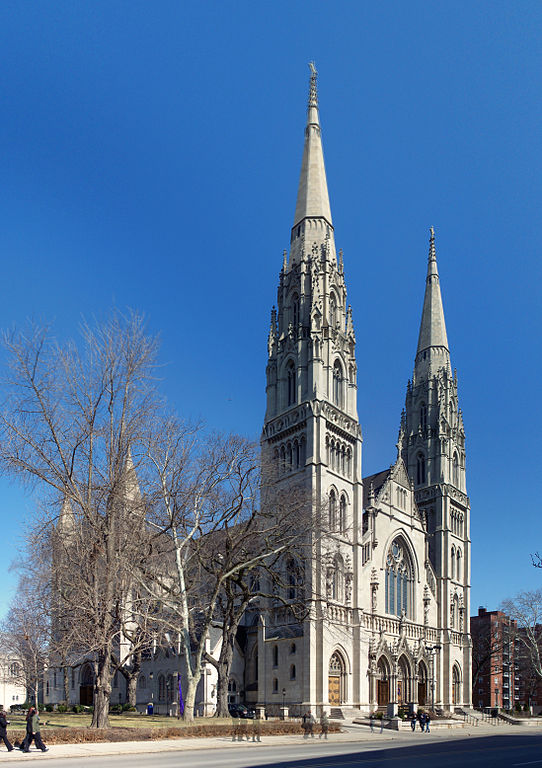

Completed in 1906, Saint Paul Cathedral is a work of Gothic Revival Architecture located in Pittsburg Pennsylvania. The church is known for its many unique details, including dozens of statues of saints, gargoyles, and other figures. The main facade is completely symmetrical and it has two towers on opposite sides, a design found in many other Gothic Cathedrals, The church is also known for its massive Gothic arches, which are filled with impressive stained glass works of art.
23. Gasson Hall at Boston College – Chestnut Hill, Massachusetts, United States
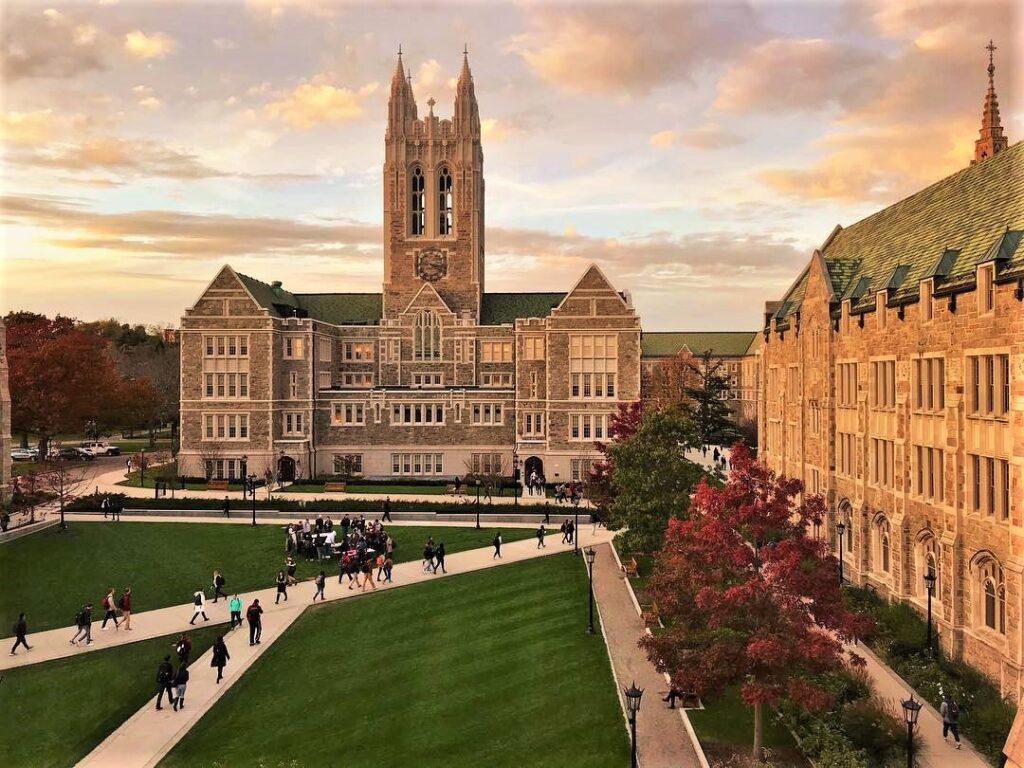
Completed in 1913, Gasson Hall is one of the many striking buildings located on the campus of Boston College. It’s a great example of the many works of Gothic Revival Architecture that are common on College Campuses throughout the world. Many people refer to this style of building as Collegiate Gothic, due to its presence at so many different schools. Gasson Hall incorporates all of the iconic elements from Gothic Architecture, including pointed arches, pinnacles, and stained glass windows.
24. São Paulo Cathedral – São Paulo, Brazil

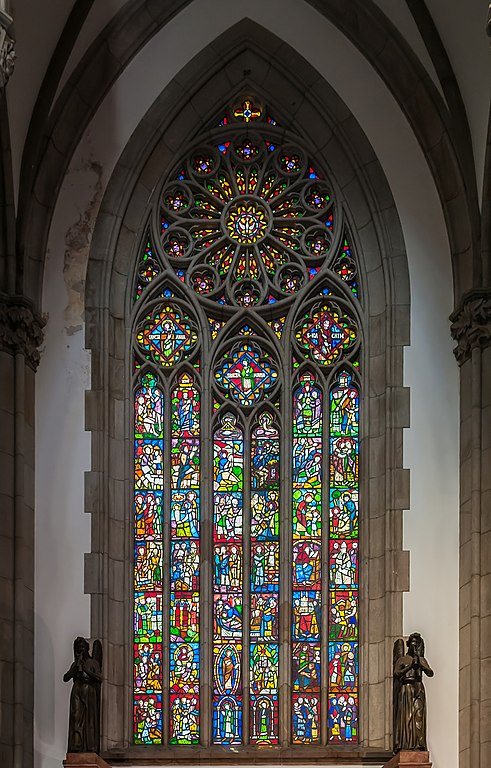
São Paulo is Brazil’s largest city and one of the world’s most populous, containing a whopping 12 million residents. São Paulo hosts an assortment of different churches which all cater to this massive population. São Paulo Cathedral is one of the city’s largest houses of worship, and its iconic Neo Gothic appearance makes it one of the most recognizable buildings in the region. The cathedral has some of South America’s most impressive stained glass windows. The church also contains one of the largest domes found in any work of Gothic Revival Architecture.
25. St. Peter and Paul’s Basilica and Church of Saint Ludmila – Prague, Czech Republic

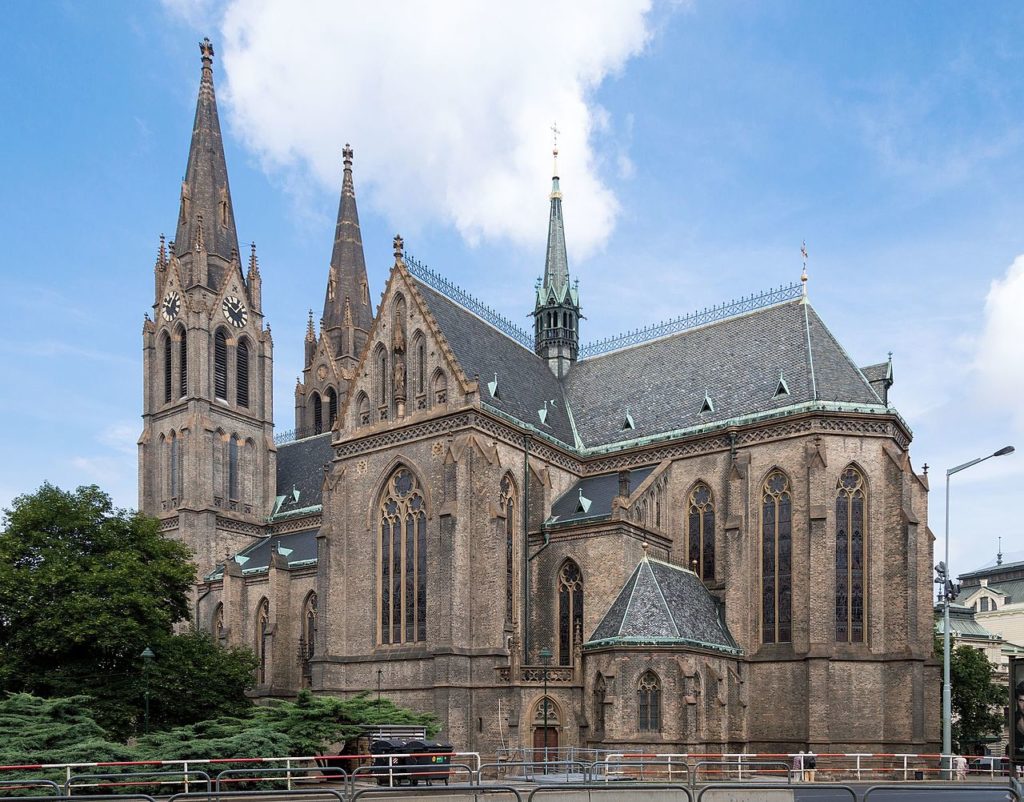
(right) Photo by Sergey Ashmarin from Wikimedia Commons
Prague is the capital of the Czech Republic and is home to several impressive examples of Neo-Gothic buildings. Two great examples of this are the similarly designed churches of St. Peter & Paul and St. Ludmila. The Church of Saint Peter & Paul is located within Vyšehrad Fortress and overlooks Prague’s Vltava River. The Church of Saint Ludmila was built in the late 19th century within one of the expanding neighborhoods outside of Prague’s historic center.
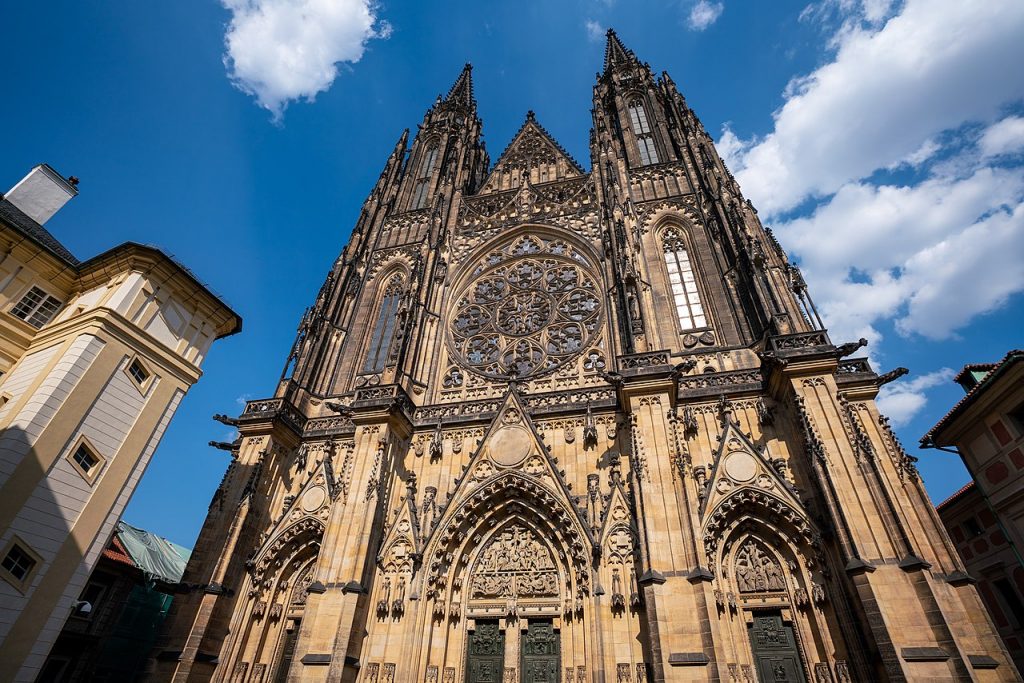
Interested in Prague? Read our article on the Architecture of Prague to learn more!
Gothic Revival Additions to Older Buildings
During the 19th century, dozens of major building projects remained unfinished all across Europe and the rest of the globe. Many of these structures, such as St. Vitus Cathedral in Prague, were begun during the original Gothic Age, during the 13th and 14th centuries. Eventually, a new passion for completing historic buildings took hold during the Revival Period of the 19th century, and many long-unfinished projects were completed. Below is a list of buildings that were unfinished in the year 1800, but were given their final touches in the Gothic Revival Style.
1. St. Vitus Cathedral – Prague, Czech Republic

St. Vitas Cathedral originated as an early stone church in the 10th century. Over time it was continuously modified and expanded. Large portions of the apse and nave were built during the Gothic Age, but it wasn’t until the year 1929 that the building was officially finished. Construction took a long pause, until the year 1861, when various groups began to push for its completion. The final portions of the nave, as well as the front facade, were completed during this final phase. Some of the new stained glass windows were even decorated by a famous Czech Painter from the Art Nouveau Period, Alphonse Mucha. Today St. Vitas Cathedral has been commemorated as a UNESCO World Heritage Site, along with several other buildings located throughout Prague.
2. Cologne Cathedral – Cologne, Germany

Cologne Cathedral famously survived the bombs of WWII to remain the second-tallest church in the world. The back portion of the church dates to the Gothic Age, but it remained unfinished up until the 1800s. During the late 19th century many additions including the towers and the front facade were completed in the Gothic Revival Style. The church’s spires were finally completed in the year 1880, and they were the tallest spires on earth at that time.
3. Ulm Minster – Ulm, Germany

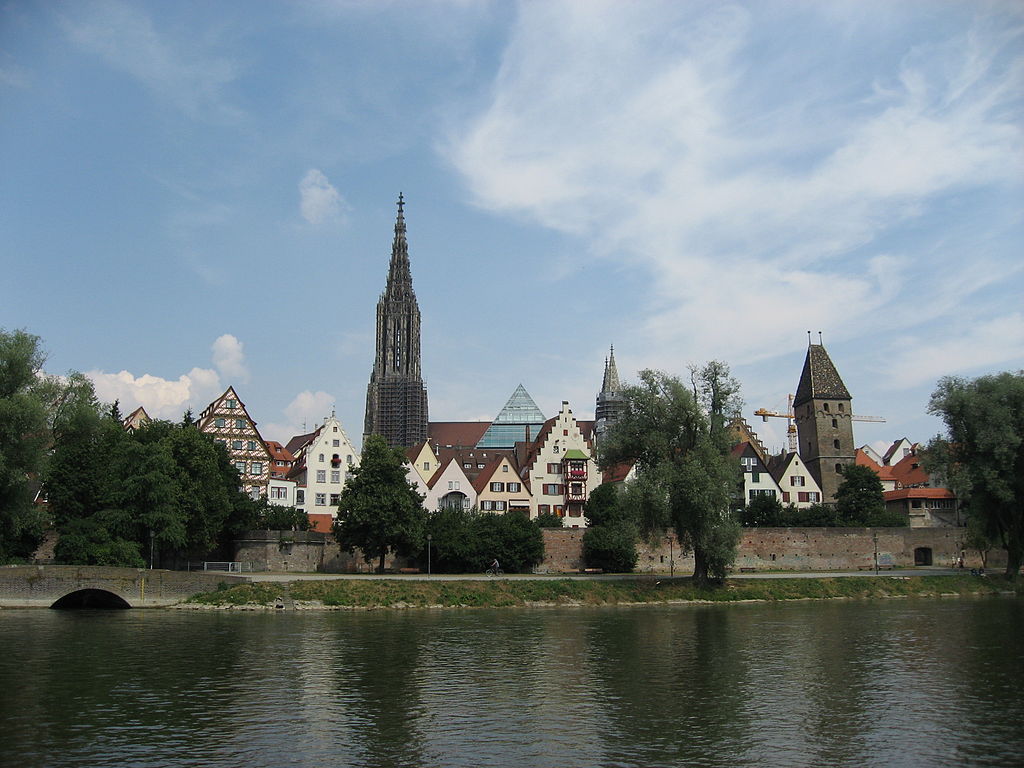
Ulm Minster is a church in Germany that dates to the original Gothic Age. The majority of the building is made from brick, and although a large tower had been planned, one was never completed. This changed during the Gothic Revival Period when a significant push was made to complete the tower and add some finishing touches to the rest of the church. The tower was finished in the year 1890, and it was built slightly taller than the towers at nearby Cologne Cathedral. As a result, Ulm Minster took the title of the World’s Tallest Church, which it still holds to this day.
4. Basilica di Santa Croce – Florence, Italy

Santa Croce is a Gothic church located in Florence, Italy. Work originally began on the church in 1294, and it contains artworks from many famous Renaissance Artists. However, the facade of the building remained unfinished at the start of the 19th century. The church had a front wall of rough-cut masonry, but its marble veneer was never installed. Eventually, during the Revival Period, work began on the facade, and today Santa Croce boasts one of the most iconic front elevations of any church within Florence.
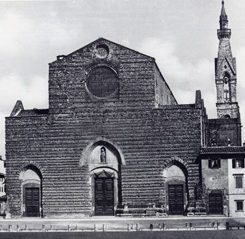
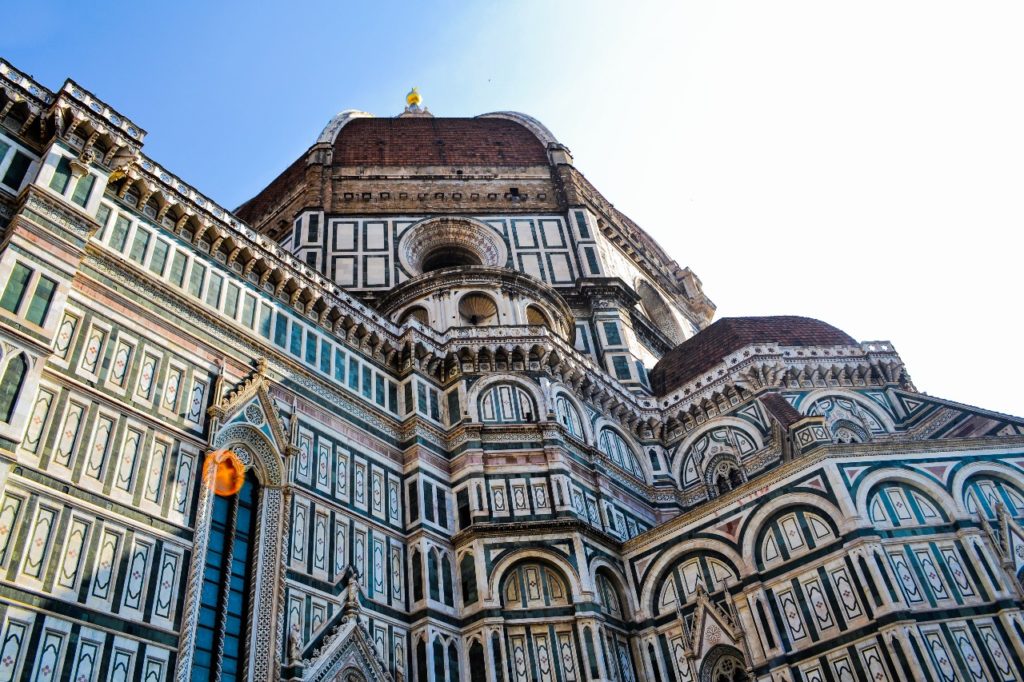
Interested in Renaissance Architecture? Check out our article on the Architecture of Florence to learn more about the birth of the Renaissance Movement.
Gothic Revival Architecture Today
Today, Gothic Revival Architecture remains one of the most prolific building styles within the 19th-century Revival Movement. Some of the world’s most recognizable buildings, like the Palace of Westminster and the Hungarian Parliament Building, were designed in this style. These structures continue to amaze and inspire the communities that they serve. Gothic Revival Architecture is still used in the Modern Age, and it’s one of the most common styles found within churches and other religious buildings. The Gothic Revival Style embodies the ideals and spirit of the Gothic Age and it utilizes traditional elements paired with emerging technologies to push the limits of Gothic Architecture.

- About the Author
- Rob Carney, the founder and lead writer for Architecture of Cities has been studying the history of architecture for over 15 years.
- He is an avid traveler and photographer, and he is passionate about buildings and building history.
- Rob has a B.S. and a Master’s degree in Architecture and has worked as an architect and engineer in the Boston area for 10 years.
Like Architecture of Cities? Sign up for our mailing list to get updates on our latest articles and other information related to Architectural History.
